
The CURRENT of HAWAI‘I Theme:
Volume � Issue � Features: An Island Reborn A Hawaiian island recovers from decades of bombing, a botanist climbs clifs to save rare plants, and social media infuencers question their reaches. Living Well: Sacred Design Get interior design tips from The Vanguard Theory’s Michelle Jaime, and learn the story behind architect Ossipof’s most sacred structure. Explore: Sydney’s Suburbs Find diversity in Sydney, spirituality in a sweat lodge, and understanding of contested lands. 0 71658 25489 02 > 3 USD $14 95 AUD $19 95
Sacred Spaces


WAIKIKI ALA MOANA CENTER 800.550.0005 AVAILABLE AT CHANEL.COM ©2017 CHANEL ® , Inc. B ®





THE BEST ADVENTURES YIELD FRESH PERSPECTIVES. Miguel Rodriguez hails from Vancouver Island, British Columbia where he’s built a life tied closely to the ocean. On Kaua‘i, where the rhythms of the sea define each day, he found his own perch to take it all in. Waimea, Kaua‘i – Hawai‘i
ALOHA ® OLUKAI.COM/ANYWHEREALOHA
ANYWHERE
HIAPO in Rum / Dark Java


SACRED SPACES
Editor’s Letter
Contributors
FLUX PHILES
22 | Art: Kaori Ukaji
28 | Culture: Steve erlman
A HUI HOU
192 | Tombstone Tourism

FEATURES
38 | The Refrain n his series The Leaping Place, Matt Shallenberger refects on layers of time and identity in awai i.
50 | Reviving Kanaloa Matthew e neef volunteers on a awaiian island decimated by decades of bombardment.
64 | Curb Your Exposure eau Flemister e amines the impact of social media on physical places, sacred and unseen.
78 | In the Light e a Gleason pro les awai i sland residents who feel the callings of crystals.

TABLE
| F T S 20
OF CONTENTS


TABLE OF CONTENTS
| S T O S
EXPLORE
90 | Moloka‘i alaupapa’s Ghosts
98 | O‘ahu Sweat odge eremony
104 | Hawai‘i Island Ofshore on Mauna ea
112 | Sydney eyond the each

124 | Family rvo caf ’s i ie ose
132 | Interior Design Vanguard Theory’s Michelle Jaime
140 | Religion Ossipof’s Thurston hapel

88
122
LIVING WELL


150 SPECIAL SECTION: THE FLUX SHOP
by
154 | Menswear eyn Spooner eather Soul 158 | Menswear Salvage ublic 162 | Womenswear Matt ruening 164 | Footwear sland Slipper 166 | Accessories Jana am 168 | Stationery Miemi o o. 170 | Footwear Olu ai 172 | Art Steven ean 176 | Apparel V pparel TABLE OF CONTENTS | S T O S
Presented
Hawai‘i Tourism Oceania




Presenting Programming Sponsor: Creative Industries Division
180 | Accessories
178 | Art eachca e
178 | Apparel
Jams orld
Martin Mac rthur
180 | Food onolulu oo ie ompany
181 | Skincare awaiian ath and ody
182 | Event Recap F otanical runch
184 | Food
James pta in

ONLINE
Poisoning a Pacific City onolulu, ewel of the world, rst among equals in the cities of the aci c, is facing an e istential threat. Since , it s estimated that , gallons of petroleum products, including machine oil, marine diesel, and et fuel have soa ed into the earth in a hill above its water supply, in service of the .S. military. Though tests indicate the water supply is presently safe, Sonny Ganaden investigates how the poisoning of onolulu may only be a matter of time. llustration by J Feducia.
Read the full story online at features.fluxhawaii.com.

TABLE OF CONTENTS | S T O S
182 IN FLUX
hef

S S S
“What do people gain from all their labors at which they toil under the sun?
Generations come and generations go, but the earth remains forever.
The sun rises and the sun sets, and hurries back to where it rises.
The wind blows to the south and turns to the north; round and round it goes, ever returning on its course.
All streams flow into the sea, yet the sea is never full. …
The eye never has enough of seeing, nor the ear its fill of hearing. …
I have seen all the things that are done under the sun; all of them are meaningless, a chasing after the wind.”
- ECCLESIASTES 1 : 1-8 , 14
couple years after launching the rst issue of F in , my father, an avid supporter of my new business endeavor, as ed me a devastating question f F went belly up tomorrow, would anyone care struggled with an answer, unsure how to respond when faced with the possible demise of what had become an e tension of myself. Then, more pointedly, he said Odds are F will fail. suc ed in my lip, trying to eep tears from spilling. hat was the point of it all, then as it all meaningless, a futile chasing after the wind had gone into ournalism because loved telling stories. started F because wanted to change the world with my writing. n the intervening years, life became an e hausting race to eep up. blin ed, and the world did indeed change. ew technology altered actions and long held beliefs. The world grew increasingly flat.
Today, information shoots across the stratosphere in a fren ied pace. Men are murdered in the streets. Mountains are poc mar ed by eager travelers. Missiles are paraded, bombs are dropped. This food of information has produced citi ens that are more aware than ever. nd yet, we respond with a TF, then shrug and go about our day.
arlier this year, in March, the ew or Times ran a piece by ells Tower titled The awaii ure. t was about the writer’s first trip to the island, in a desperate attempt to escape the news. Tower made some missteps, calling the most awaiian thing about a commercial luau its proficiency at e tracting tourists’ dollars.
eedless to say, people everywhere with love for the islands were miffed.
owever, for all of Tower’s crass ruminations, can’t blame him for wanting to escape his world and set foot into ours. is simplistic character tropes and hope for a paradisiacal den these have all been parts of the selling of Hawai‘i since aviation innovation enabled mass travel here decades ago. et Tower stumbled upon a bit of magic, too. The magic has to do with the moon, the thud and rustle of the surf, he writes. The magic is wor ing on Jed, my year old son. e is trying to seduce a girl of or so. She is engrossed with her tablet. cultist of the night s y, Jed touches her wrist, points overhead and says, Stars.’ The girl’s eyes do not flic er from her screen. There is something to be learned from Tower’s son. e has not yet been drawn to consume life online, to frivolously trample revered sites in order to attain the perfect posts or promote commercial endeavors. e has not yet been e posed to the flippant dissemination of information that threatens to undermine what have wor ed so hard to create media that see s not only to create more informed citi ens, but to better the world in which we live. nstead, he still can simply en oy the stars. t has ta en me five years to come to terms with my father’s statement, to be O with the fact that what hold sacred may be ta en from me. ecogni ing this, we continue to adapt and evolve F in today’s changing media landscape, incorporating new sections that celebrate the good things in life and prompt dialogue about cultures around the world. ather than focus in on the clamoring around me, loo up, marveling at the stars.
With aloha, isa amada Son TO lisa nellamediagroup.com
EDITOR’S LETTER |
14 | FLUXHAWAII.COM


Take me to NYC. Shows, art, shopping, cronuts? There are two types of cards: the Visa Signature ® card and the Platinum Plus ® card. The card you receive will be determined by several factors including your income and credit history. The benefts and bonus miles above apply to Visa Signature® cards only. The Annual Fees, benefts and bonus miles for Platinum Plus® cards are diferent. For more information on the diferences, see the Features section accompanying the application. The Visa Signature card benefits described herein are subject to certain restrictions, limitations and exclusions. For more information about rates, fees, other costs and benefits of this credit card, or to apply, visit AlaskaAir.com or refer to the disclosures accompanying the application. This credit card program is issued and administered by Bank of America, N.A. Visa and Visa Signature are registered trademarks of Visa International Service Association and are used by the issuer pursuant to license from Visa U.S.A., Inc. Platinum Plus is a registered trademark of Bank of America Corporation. ©2017 Bank of America Corporation. Alaska’s Famous Companion Fare™ Offer -30,000 Bonus Mile Ofer -First Checked Bag Free -3x Miles on eligible Alaska and Virgin America Purchases
MASTHEAD
“Journals, because they form a passage between my internal and external self.”
PUBLISHER
Jason utinella
EDITOR isa amada Son
CREATIVE DIRECTOR ra Feducia
MANAGING EDITOR
Anna Harmon
DESIGNER
Michelle Gane u
PHOTOGRAPHY DIRECTOR
John oo
PHOTO EDITOR
Samantha oo
COPY EDITOR
ndy eth Miller
EDITOR - AT - LARGE
Sonny Ganaden
IMAGES
J Feducia
sh Gowan
Jef awe
ryce Johnson
Lila Lee
ayne evin
Franco Salmoiraghi
Matt Shallenberger
“Being connected to a universal consciousness, because it allows for an encompassing and empathetic understanding of existence.”
hat is sacred to you
CONTRIBUTORS
Matthew e neef
unica scalante
eau Flemister
Le‘a Gleason
Tina Grandinetti
Travis Hancock
Jef awe
rittany yte
aycee Macaraeg
Timothy . Schuler
Matt Shallenberger ae So ot
WEB DEVELOPER
Matthew McVic ar
ADVERTISING
Mi e iley
GROUP PUBLISHER mi e nellamediagroup.com
helsea Tsuchida MARKETING & ADVERTISING EXECUTIVE
than est MARKETING & ADVERTISING EXECUTIVE
OPERATIONS
Joe V. oc
CHIEF REVENUE OFFICER oe nellamediagroup.com
Gary ayne VP BUSINESS DEVELOPMENT gpayne nellamediagroup.com
Mitchell Fong DESIGNER
Aja Toscano DIGITAL CONTENT COORDINATOR
INTERNS
unica scalante
Gabe Estevez
General nquiries contact flu hawaii.com
by ella Media Group, . ontents of F awaii are protected by copyright and may not be reproduced without the e pressed written consent of the publisher. F awaii accepts no responsibility for unsolicited manuscripts and or photographs and assumes no liability for products or services advertised
PUBLISHED BY: ella Media Group .O. o onolulu,
“Language. Being able to share a language, along with all the customs tied to it, is a phenomenon that makes us human.”
herein. F awaii reserves the right to edit, rewrite, refuse or reuse material, is not responsible for errors and omissions and may feature same on fu hawaii.com, as well as other mediums for any and all purposes.
F awaii is a triannual lifestyle publication.
| S S S

Find out how Hawai’i Life is changing the way that people do real estate in Hawai’i—simpler, smarter, with heart. 800-667-5028 HawaiiLife.com You’ll love our step-by-step Transaction Management process. It makes selling or buying as easy as 1-2-3.
Daniel Semisi, Transaction Coordinator, Oahu

On the Cover
On the cover is an image by Tara oc , the woman behind the popular surf fashion blog adyslider, who we interviewed on page for urb our posure, a story on social media’s impact on place. n a poignant call to creatives in a blog post titled, Sacred laces, she questioned the way the social community herself included portrays and uses awai i in its wor or play. hen a company emails you asking to work on a campaign it is easy to compromise the people and places around you, she wrote online. ’m guilty of this. will shoot a lifestyle campaign at the e pense of a photogenic location. f we’re to be good stewards of the land in awai i where resources are in fact limited then we should probably eep in mind what a photo connected to thousands of followers could do to a place.

Brittany Lyte
rittany yte has reported from ussia, oland, and across the nited States, interviewing sub ects ranging from the alai ama to Ghostface illah of the u Tang lan. er writing has covered a similarly wide range of topics, from ative awaiian sovereignty movements to undocumented to ic waste buried in onnecticut, the latter investigation inspiring a state law change. For this issue of F , she pro led an e ploratory botanist on aua i trying to save rare endemic plants from e tinction, and a reporter telling the story of indigenous groups rallying to preserve areas culturally and spiritually signi cant. ach of us, regardless of whether we are spiritual or if we adhere to a religion, hold something sacred, she says. place, a relationship, a ritual whatever it is that ma es us feel humble and awa e in its presence is what consider sacred.

Franco Salmoiraghi
Franco Salmoiraghi has documented important moments, daily life, and disappearing sights in awai i for more than ve decades. n the mid s, and for the ne t three decades, when ative Hawaiian activists arrived on the shores of aho olawe in an efort to halt target bombings conducted by the .S. military, Salmoiraghi’s star , blac and white images memoriali ed the landings on and desolation of the isle. These images are reprinted here for eviving analoa on page . i e his documentary wor , which records important occasions in awai i’s history, his landscape images honor sacred sites, some of which no longer e ist today, li e the spring fed ueen’s ath in the awai i sland area of alapana, the historic shing village that was engulfed in lava from lauea Volcano. The wor ’ve done the years photographing aho olawe, the years of awai i’s sugar industry, or my travel e periences all of it, it’s priceless, the year old says. got to see so many things that were virtually inaccessible, and I consider it a gift.

Matt Shallenberger
f there is something of the idea of sacredness being lost today, thin it is, in part, a move away from small, personal relationships less time spent alone, more time trying to do two things at once, says ailua born, large format landscape photographer Matt Shallenberger, who dove deep into his family heritage and the umulipo for his series of photographs The Leaping Place, which captures the vastness of Hawai‘i Island on page . thin it’s important to protect the things that allow us to build sacredness in the rst place attention, quiet, solitude. hope people nd some of that in my photographs, or inspiration to go nd it for themselves. ow residing in ltadena, alifornia, where his wife recently gave birth to their rst child, Shallenberger focuses his present wor on contemporary relationships to fol lore and mythology.
18 | FLUXHAWAII.COM CONTRIBUTORS | S S S
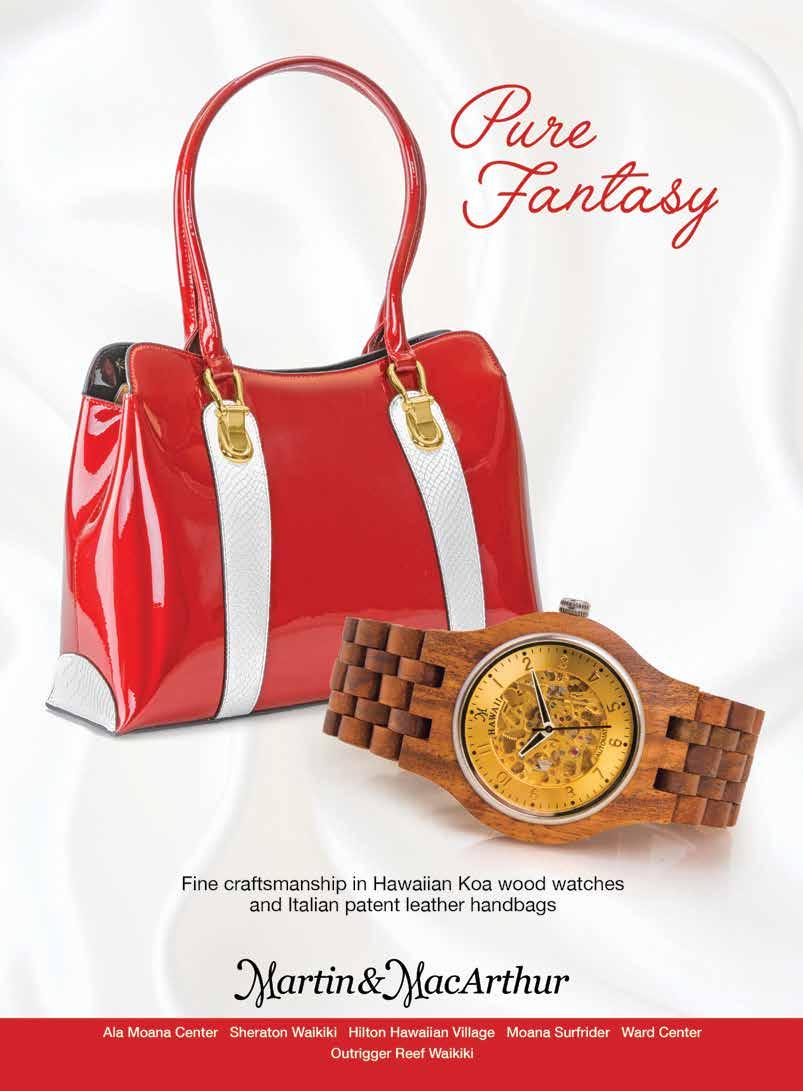
 Petroglyph at Pu‘u Moa‘ulanui on Kaho‘olawe. Image by Wayne Levin.
Petroglyph at Pu‘u Moa‘ulanui on Kaho‘olawe. Image by Wayne Levin.
SACRED SPACES
“Slowly, and without any fanfare these jewels of creation have slipped into oblivion nevermore to grace our world.” —Steve Perlman


Body Language
Artist Kaori Ukaji incorporates the most personal objects and internal inspirations into her work.
TEXT BY RAE SOJOT
IMAGES BY JOHN HOOK
aori a i’s home is an e ercise in eclectic, artistic delight. colorful woven rug is splayed across the floor, and a merry assortment of tchotch es invites inspection. aintings, s etches, and photographs te ture the space with a well worn cheeriness, while a spherical, metal wire ovum nearly feet in diameter, created by Stephen ang, a i’s husband and fellow artist, hangs over the seating area. cross the room, a glass ar featuring stratums of wooly material also begs inquiry t is fur collected from mi, the couple’s dog. earby, a low lying apothecary dresser showcases nearly miniature compartments, each retrofitted with a brightly patterned enamel nob. eatly penned labels designate the contents within Sandpaper. Sunbloc . hal . Two drawers, one atop the other, offer more cryptic labeling Things. Things Spill. a i chuc les before offering a lighthearted yet similarly oblique e planation. ou have things and then sometimes those things spill over. ntentionally or not, a i refrains from divulging the drawers’ treasures. awai i sland based artist, a i is both private and pleasant. Originally from Japan, she describes having a quiet and responsible childhood, when a daily routine of school, piano lessons, and afternoons spent drawing and crafting paper dolls offered sweet contentment. She was especially fond of tracing paper, with its sil y, onion s in sheets, and the dot matri printer paper with its accordion li e continuity that her grandmother brought home in reams from her government ob. Such inclination toward paper’s tactility and form would emerge as a leitmotif in a i’s art years later. y high school, a i’s affinity for art had sharpened to a focus. ewing to her father’s pragmatic advice of getting a s ill in hand, she listed designer as her chosen career path in her high school yearboo . pon graduating from college as a
At her Hawai‘i Island studio, Kaori Ukaji mines her inner being and her body for inspiration, often incorporating her own skin, hair, and even earwax into her work.

FLUX PHILES | TS 22 | FLUXHAWAII.COM



trained graphic designer, a i settled into the professional world as an artist in To yo. ut at age , a i felt an unmista able urge to fly on. eaving Japan and her position as a research associate in Musashino rt niversity’s graphic design department, she embar ed upon a year of travel. The ourney was summarily cut short. lthough had never been here before, somehow, arriving in ilo made me feel that came bac , a i recalls of landing in awai i. My feeling here was so deep, could not leave. mysterious power compelled her to stay, and over the ne t years, a i’s art came to reflect her enigmatic interior, echoing the ever changing susurrations of self.
f a i’s art is a barometer of her internal state, her ear serves as the bridge to that inner sanctum. To a i, the ear is most sacred. go almost into a trance, a i says of the rhapsodic feelings that surface when she gently touches the sensitive areas of her inner ear with a
slender pic . itual e ploration of her ear allows her to tap into a sensual, mystical e istence. This is her mandala, a glimpse into the entirety of her being and the inner ecstasy that resonates there. rawing on that energy, a i then translates it into her art.
For years, a i’s pieces focused on graphite, paper, the color blac , and straight lines symbolic representations of the tightness and strength she felt within. ut as years passed, her inner world softened, and so, too, did the lines of her art. n the early s, a een interest in other materials rose to include her own s in, hair, and ear wa . i e the e ploration of her ear, canvassing her body became a daily ritual for a i, and she felt no hesitation in subsequently using the s in and hair she collected in her art. For a i, it was a statement both pragmatic and profound sing elements of her body in her art was a natural e tension of herself. round that time, a i also found
“Always my feeling is my art, always myself is my art. It is like a river flowing someplace without my decision,” says Japan-born Ukaji, who speaks of her art as an embodiment of self.
24 | FLUXHAWAII.COM

FLUXHAWAII.COM | 25

herself pulled to another powerful color red. lac is me, but red is me, too, a i says. hen she married ang years ago, a i became drawn to true red today she describes the color as having evolved to a red orange hue, li e blood e posed to air.
This red orange hue was present in Serenely Proliferating , a i’s installation for Artists of Hawai‘i 2017 at the onolulu Museum of rt. She fell into a meditative state during its construction, as she had with pieces in the past, prompted by deep concentration and the repetitive movement of her hands. She imagined the artwor s as a metaphysical ourney through her body, to be intrinsically felt as much as seen. t’s li e something slowly spreading, a i e plains of the feminine mystique a concept of womanhood she is e ploring that is emerging from the art. rimson is diffused among lush, cylindrical folds of white bath tissue. arge, hanging embroidered canvases, their fronts and bac s e posed, display the delicate recursive stitching of thousands upon
thousands of thread loops. Two wor s, created with s in she peeled from calluses on her feet and then dyed a rich orange red, are e quisite, organic interplays of matter and interstice. For a i, each piece in Serenely Proliferating is a rapturous hymn to her body. only ma e pieces of what am now, she says. ac at home, the apothecary dresser silently holds its cache of treasures. Sewing. Graphite. Glue. The contents of Things and Things Spill remain wondrous and unrevealed. Sitting near the dresser, a i spea s of her art as an embodiment of self, a suffusion of her ever evolving identity. lways my feeling is my art, always myself is my art, she says. a i has discovered a new energy that may soon be influencing her wor t is li e a river flowing someplace without my decision, she says of the quietly e panding feelings and changes occurring within her. They swell up and in and around, waiting, perhaps, to spill over.
Ukaji’s installation for Artists of Hawai‘i 2017 at the Honolulu Museum of Art, Serenely Proliferating , presented her artworks as a metaphysical journey through her body.
For more information, visit kaoriukaji.com.
26 | FLUXHAWAII.COM

Let the Earth Sprout
Exploratory botanist Steve Perlman descends Hawai‘i’s cliff faces to save plants on the verge of extinction.
TEXT BY BRITTANY LYTE
IMAGES BY BRYCE JOHNSON
S teve erlman punches the spi es of his hi ing boots into the face of a vertical cliff. Spread beneath him is alalau Valley, a dramatic landscape spectacularly wrin led by wind, water, vo lcanic lava, and the spines of soaring pea s. idden within this million year old topography are wild plants that e ist nowhere else on earth.
erlman is roped to the trun of an old hi a lehua tree that’s rooted on the valley rim. is body dangles parallel to the valley floor , feet below. Twisting his suntanned nec , erlman drops his ga e into alalau’s impossibly beautiful bowl, scanning the cliffside for the fragile botanical treasures it holds.
awai i’s endemic plants arrived in the islands millions of years ago as seeds, mostly transported by wind or ocean currents, or in the gut of a migrating bird. From these single seeds evolved a much larger collection of species now nown as awai i’s native flora. ubbed the endangered species capital of the world, awai i is home to hundreds of varieties of threatened plants and animals. ll told, of the state’s , native plant species have already gone e tinct.
liffs are the last frontier for many of these endangered plants due to their sheer inaccessibility. fortress of weathered basalt, preserved by e treme isolation and agged terrain, the alalau sea cliffs are one of the richest remaining refuges for the state’s rare botanicals. redators who indiscriminately eat greens, endangered or not, can’t easily access the steep slopes. Minimal hoof traffic also means less erosion and fewer chances for the invasive weeds that tend to smother out natives to arrive and ta e root.
ut such paradises of biodiversity are still under attac from plant disease, e treme weather, and nimble goats whose teeth threaten to chew out whole species. The loss of even ust one of the delicate plant varieties ensconced in the folds of the alalau cliffs could hamper the natural world’s resiliency and hinder its ability to provide food, climate stabili ation, and shelter. lso at ris of being lost are any untapped medicinal powers these plants might possess. nd so, it is erlman’s ob to get there first.
escending into the alalau gorge, erlman finesses his way around a precarious rotting log. e avoids entanglement with a warped tree protruding from the fluted roc , but endures a battering by weeds armed with ra or sharp thorns growing in nee high clumps. e seems not to notice the shallow slices now scarring his arms. e is headed to a grouping of eight shrub li e plants, which he has been chec ing on for years. t the age of , erlman has been an e ploratory botanist for decades. former hobbyist roc climber, erlman moved to awai i from olorado in the s to wor with plants in one of the few places in the nited States where the age of botanical discovery remains far from over.
Exploratory botanist
Steve Perlman pioneered the practice of rappelling cliffs in order to save rare plants from extinction.
FLUX PHILES | T 28 | FLUXHAWAII.COM


oupling his love of bouldering and e treme hi ing with the allure of awai i’s unwonted greenery, erlman pioneered the practice of rappelling cliffs in order to scour for plants in previously uncharted terrain. is ob ective then was the same as it is now iscover and, ultimately, save rare plants from e tinction.
n awai i and across the South acific, erlman’s use of ropes to traverse waterfalls and scale brea nec bluffs has led to the discovery of more than species, including yanea ole oleensis, a vulnerable flowering plant in the lobelioid bellflower family all of which are endemic to this island chain that is found on aua i’s Mount apalaoa. e also led the rediscovery of many plants once thought to be e tinct. There are species that evolved on cliffs and no one had really sampled them, erlman says. Today, he is employed by the awai i epartment of and and atural esource’s lant tinction revention rogram, or , which was established in to save the native species left in the state that each had fewer than plants remaining in the
wild. s botanists have gained a greater understanding of the plant diversity on cliffs and in other hard to reach places, do ens of plants have been added to the list. Only a few species have become strong enough to warrant removal from the program’s guardianship.
hile plant conservation groups typically focus on regenerating endangered species in botanical gardens, targets those that still e ist in nature. Guam and uerto ico now have plant conservation programs modeled after awai i’s. Four days each wee , erlman hi es and rappels to remote sites, where he collects wild seed for propagation or out plants nursery grown species to establish new populations. Some of these sites can only be reached this way, or by helicopter.
Two hundred feet below the alalau ridgeline, erlman arrives, elbows bloodied, at the site of the largest nown cluster of the anomola variety of lantago princeps in the wild. i e a little tree, the lantago, which is a rare flowering species in the plantain family and endemic to awai i, has a rosette of green leaves
In Hawai‘i and across the South Pacific, Perlman’s use of ropes to traverse waterfalls and scale breakneck bluffs has led to the discovery of more than 50 plant species.
30 | FLUXHAWAII.COM


attached to a long, woody stem. There are eight of the anomola variety on the cliff. There are two additional sites on aua i with smaller clusters of it. ll told, only of these particular plants e ist in the wild.
f it’s a polar bear or a panda, something that’s really cute, people want to save it, erlman says as he collects seed from a spi y, flowering lantago stamen. hen it comes to plant species, often people don’t really care. Some people thin that as long as it’s still green out here, and there are guavas for the pigs to eat, then it’s no problem. ut if we lose them, they’ll be gone forever.
Of the eight lantago plants on the alalau cliff face, three are in flower and one is bearing mature fruit. t is the latter that erlman collects seeds from, noting the status of the others in his poc et field boo . e tuc s the seeds into a pouch on the bac of his vest. e will ta e them bac to the ational Tropical otanical
Garden, where they will be planted and nurtured. ith any luc , the seeds will produce offspring that can be introduced to the wild. n a few wee s, erlman will return to the site to collect more mature fruit.
hen this lantago princeps was rst discovered on the alalau clif face by erlman’s longtime partner, en ood, in the early s, it was nearly double the number of plants. Over time, goats chewed up almost half of the original population. dditional ha ards have come in the form of loss of pollinators and e treme wind. urricanes wa and ni i, for e ample, blew hundreds of e tinction prone species of the alalau clifs. more sinister threat to these species is the blac mar et for rare plants. fforts by botanists li e erlman to eep secret the location of awai i’s most vulnerable plants are reactions to the small but destructive number of thieves who don headlamps and embar on night hi es to find and
uproot plants that are as scarce as they are precious. single seed from an endangered palm, shrub, or flower can yield as much as times the price of heartier species when sold. ecause of this threat, there are some plants of which only erlman nows the location. ut it’s not clear how much longer he will be able to protect them since the current fiscal climate for environmental programs li e are blea . ast fiscal year, was only able to raise percent of its million budget, with percent of funds coming from federal monies. The program’s budget is poised for another percent reduction in the upcoming fiscal year, which would effectively reduce the current program by half. hopes to bolster its funding with help from private sources, including members of the public who understand how much there is to lose.
Meanwhile, fresh threats, such as new slug species, are surfacing.
32 | FLUXHAWAII.COM

FLUXHAWAII.COM | 33 Our website gives you accurate, real-time information and powerful search tools from Hawaii’s neighborhood expert. Whether you’re buying, selling or just looking around, do it faster and better at LocationsHawaii.com. Real estate is a race. Consider us your head start. (808) 377-4648 • LocationsHawaii.com RB-17095

botanist may spend years encouraging a plant to thrive, only to suddenly lose it to an une pected pest, or to the mouth of a hungry goat. erlman estimates that he’s watched a couple do en plants go e tinct during his four decades of wor . t can be hard not to feel defeated, he admits. There are people who have become depressed about this, people who actually have to ta e medication, li e ro ac, erlman says. ou go out there to a plant you’ve been collecting seed from for years you’ve been monitoring it for years, it’s li e a member of your family and it dies. t’s sad. t’s really tragic. t’s li e wor ing in hospice for plants.
For years, erlman cared for a righamia insignis nown as awaiian palm, lulu, or colloquially as cabbage on a stic on aua i’s Mount aupu. hen he discovered the endangered succulents here in , there were a do en plants in number. ut over time, the endemic cluster was whittled down to a single survivor, and when erlman arrived to the site one day in , he found that this remaining awaiian palm had died. erlman unearthed it, ripping its roots from the
ground. Then, succulent in hand, he drove to a bar and ordered a drin . Setting the wilted plant down on a table, he gave it a heartfelt toast. e called his wife to say he wouldn’t be home for a while, before proceeding to drown his sorrow in beer. ater that night, erlman wrote a poem about the death of Mount aupu’s last righamia insignis
“Slowly, and without any fanfare These jewels of creation have slipped Into oblivion
Nevermore to grace our world O man, who can measure What we have lost?”
Today, only one righamia insignis is believed to be left in the wild. ut erlman is comforted by a simple, scienti c fact There is still hope. sn’t that incredible erlman says. ven when you’re down to one plant left, it is not doomed. e don’t give up, because diversity can come bac . ll of these plants have a ghting chance.
The loss of even just one of the delicate plant varieties ensconced in the folds of the Kalalau cliffs could hamper the natural world’s resiliency and hinder its ability to provide food, climate stabilization, and shelter.
34 | FLUXHAWAII.COM
WE CAN PUT YOUR FIRST

WITHIN REACH.
With so many new communities being built throughout Hawaii, it’s the perfect time to think about buying your frst condo, townhome or single-family residence. Let us guide you through the loan application process and explore all the fnancing options available.
To fnd a residential loan offcer near you, visit asbhawaii.com/home-loans
Member FDIC NMLS #423168
home

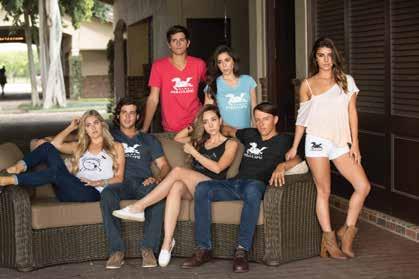

MARK YOUR CALENDAR:
WORLD CLASS POLO COMES TO WAIMANALO
SUNDAY, SEPTEMBER 16 , 2017
GATES OPEN AT NOON HONOLULU POLO CLUB, WAIMANALO POLO FIELD
The Hawaii International Polo Association, (HIPA) Invitational Championship Event (ICE) started originally in 2012 as the White Summer Soiree. From there the Event Team at Dawson Media Group went on to produce Polo Events at Fort Shafter, Schofield Barracks and the Hawaii, Maui and Honolulu Polo Clubs. The goal is to produce up-scale Polo Events, support the US military, local polo communities and raise the public’s awareness of polo in Hawaii.
THE HAWAII INTERNATIONAL POLO ASSOCIATION WAS FOUNDED IN 2013 WITH THREE PRIMARY PROGRAM INITIATIVES:
ONE: celebrate Polo’s unique history in Hawaii dating back to 1880, TWO: establish an equine retirement program, THREE: working with Hawaii’s at-risk youth via horsemanship clinics.
It was determined that establishing an Annual event and fundraiser would be needed to fund program initiatives. With this in mind the Event Team at Dawson set out to bring World Class Polo to Hawaii and established the HIPA Invitational Championship Event. This year is the 3rd Annual event bringing some of the very best professional polo players from across the globe to play polo in Hawaii.
QUOTE FROM HIPA PRESIDENT AND FOUNDER MR. CHRISTOPHER DAWSON: “Hawaii has rarely seen this high level of polo, and it is my ambition to make it a regular thing. This in turn, will qualify Hawaii to be a part of the FIP (Federation of International Polo). When that happens, Hawaii would qualify as a stop on the International Pro Tour drawing polo enthusiasts from all over the world to our beautiful and unique location. Very similar to what the World Surfing League has done for surfing and the SONY Open has done for golf. Internationally renowned Events showcasing Hawaii.”
HIPOLOASSOCIATION.ORG
FLUX FEATURE
The Refrain
In The Leaping Place, a photographer reflects on layers of time and identity in Hawai‘i.
TEXT AND IMAGES BY MATT SHALLENBERGER

I. THE MASTER OF SONG
When was young, made maps. For a while, we lived in a house in Virginia with woods behind it three small forests, connected by a long stream, interrupted by a marsh with winter goose nests. named the regions of the forest as if were an archaeologist, imagining villages and roads erased over time, traces so subtle that only could see them. s a landscape photographer, see every image as an attempt to get bac to that e perience, nding places would have named as a id. oth sides of my mother’s family left ortugal for awai i in the s to wor in sugarcane. She was born on the ig sland, a few wee s before the end of orld ar . My father’s family is from ustria, by way of alifornia. biologist, he came to awai i in the s to study native bird life. was born on O ahu years after my ancestors immigrated, and years after the first uropean landfall.
hen was years old, my dad’s wor too us to Virginia, Oregon, ew Me ico, and then to Virginia again. My parents moved bac to the islands when left for college, and now they live near aimea, on the last remnant of what was my grandfather’s cattle ranch. Most of my mother’s family resides somewhere near where their forbearers first settled, along the m ua oast.
More by coincidence than by design, each photography series of mine begins with finding a boo . n my parents’ house, the umulipo is mi ed in among histories, field guides, and family photo albums. ’m sure saw it as a id, but was never formally introduced to it. The umulipo is popularly nown as the song of creation, and describes the cosmological beginnings of Hawai‘i through to the birth of animals, plants, gods, and men. onceived and memori ed centuries ago by ha u mele, or chant tellers, the umulipo serves various purposes. i e the stories in my mother’s family, it
connects children to their lines of ancestry. i e my father’s biological ta onomies, it classifies and organi es all the forms of animal and plant life. The themes, modes, and landscapes were all familiar to me. ediscovering the umulipo as an adult, while visiting my parents, was li e finding a map of a forest already new intimately. This became a conceptual starting point for e ploring my own history.
studied the umulipo first as a wor of poetry, comparing different translations, and focusing on the way the story was told stories reflecting upon one another, paired opposites, similar and repeated symbols describing birth and death, cultivation, world creation, genealogy. The umulipo was meant to tell several stories simultaneously political, environmental, personal, historical. t incorporated hidden meanings, known as kaona, to connect the layers. fter studying as many interpretations as could find, copied out the poem, combining different translations and removing all annotation, filling the holes with my own scattered notes. made my first map since childhood, mar ing places significant to my family history. nd then too pictures.
ach of the photographs is a large format lm landscape of a place with some signi cance to me or my family history, with each titled after a chapter in Martha ec with’s translation and commentary. n my photographs, some of the interpretations are literal, attempts to illustrate scenes from the stories. Others are metaphorical, or personal. Most are a foggy combination of all three.
The rst photograph in the series is titled The Master of Song. n this chapter, ec with e amines the ha u mele himself, describing his vocal style and use of layered imagery. My photograph shows a cement pylon deep in a awali i Gulch, a remnant from one of many trestle bridges built for trains that carried sugar up and down the ma ua oast. bove this
is where my great great grandfather built his house. i e many of the relics of industry, the pylon has been overta en by the forest, and is now di cult to place in time or scale. t is, for me, a totem, a place to appeal to my own ancestors, my own family gods. eople often assume that photographs are meant to say something specific, but more often than not, they’re an unpredictable mi of intent and instinct, and are offered as questions rather than statements. fter sequencing and titling the series, reached out to learn what it reveals to people with different relationships to awai i conservationists li e my father, who see a story of invasive species ta ing over native ones immigrants, li e those in my mother’s family, who see the small evidences of their history, the cement among the lava mainlanders who have never been to awai i, who see a landscape more violent and comple than the idyllic paradise they’ve been painted and ative awaiians, who see the conflict between the landscape of the umulipo’s time and that of today, altered by coloni ation and industry. That’s one of the reasons call this series The Leaping Place The title refers to a leina a u uhane places from which departed souls begin their ourneys to the underworld. Some of these locations are commonly nown, and others are a mystery. These are the places where we return to the beginning. come from awai i as a ama ina local but not a ana a maoli ative awaiian , returning home but also discovering. awai i is made up of countless stories. envision leaping places as pathways to our common past, and to conversations about our shared present. ach photograph is a haunted step bac into my own history, and a chance to as others about theirs. nd for those whom never meet, perhaps it’s a place on their own ourneys to stop and imagine.
40 | FLUXHAWAII.COM


PROLOGUE TO THE NIGHT WORLD
II.
III. THE REFRAIN OF GENERATION
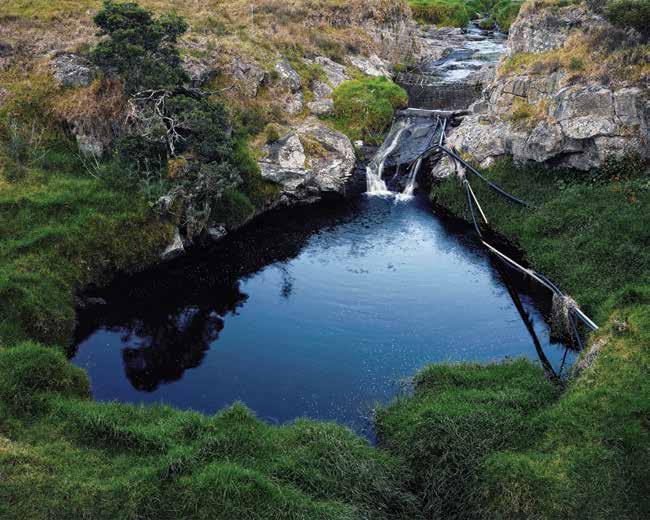 IV. BIRTH OF SEA AND LAND LIFE
IV. BIRTH OF SEA AND LAND LIFE
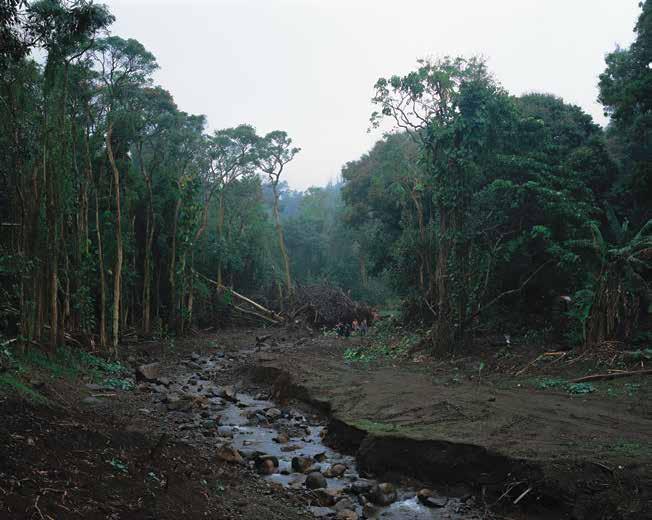 VIII. THE NIGHT DIGGER
VIII. THE NIGHT DIGGER
 XIII. THE FLOOD
XIII. THE FLOOD



 X. THE DOG CHILD
X. THE DOG CHILD

 XVII. THE DEDICATION
XVII. THE DEDICATION

XVIII. THE GENEALOGIES
FLUX FEATURE
Revivin g Kanaloa
A small number of people work to breathe life back into Kaho‘olawe, a Hawaiian island decimated by decades of bombardment by the U.S. military.
MATTHEW DEKNEEF
BY
TEXT

BY
IMAGES
WAYNE LEVIN & FRANCO
SALMOIRAGHI

Pa‘a pu ka mana‘o o no ka pono o ka ‘ā ina I mua na pua Lanakila
Kaho‘olawe.
Together in one thought to bring prosperity to the land Forward young people and bring Salvation to Kaho‘olawe.
“MELE O KAHO‘OLAWE” BY
HARRY KUNIHI MITCHELL
Blistered raw by the sun, aho olawe, in the recesses of its hardpan valleys and soil stained with red dirt, loo s li e a heart e posed. On the northeast region of the island, a reforestation effort runs the impressive, if e hausting, grid of three football fields. ong blac rubber hoses bloated with water spool perpendicular down angular slopes with the adroit ambition of arteries. They heave, deflate, and occasionally spray mist alongside rows of native flora, the bloom of tender ma o, ilima, and a ali i barely rising past the an le. hile this soft machine is a hopeful sight, its irrigating sound a wea hiss of freshwater into the wind is regrettably reminiscent of a person, breathing through a host of tubes, on life support.
On our third day on aho olawe, we stac ed roc s. nvironmentalists, engineers, archeologists, awaiian cultural practitioners, doctors, and ournalists, the of us had traveled to see the island’s scars for ourselves, and what could be done to heal them. Titles aside, we might have more appropriately been referred to as students of the aho olawe sland eserve ommission, a program that organi es a monthly stream of volunteer visits, though its funds are running dry. For an hour, we arranged the roc s into compact raised circles in the highlands of anapou, one of eight ili, the traditional subdivisons that comprise the island, building ma eshift planters that will later
be scattered with seeds. The notion is that, in this windswept region, the roc s will protect the ernels from wind but allow for dirt to accumulate over them, fostering an ideal opportunity for germination. Some will sprout, most won’t, we were told. place li e aho olawe can ta e those chances there’s nothing left for it to lose. ll this because you can’t dig on aho olawe. istory won’t allow it. From to , the island’s square miles were used as a bombing range and training facility by the nited States military, a year wound opened in response to the Japanese attac on earl arbor during . The devastation of this preemptive violence is found everywhere in the landscape, which is poc mar ed with erosion that is worsened by harsh tradewinds and a lac of vegetation. The island is in a perpetually parched limbo ithout plants to absorb rainwater, the island’s soil can’t replenish itself and runoff races to the sea without topsoil, plants that could unloc the foundation for any semblance of an ecosystem struggle to ta e root in the hardpan. This erosion began long before wartime, with the introduction of sheep, cows, and goats, which overgra ed the island through the military occupation by , the goats numbered , . Today, they are gone. ut as the e terior of the island wears away at a rate of nearly million tons of soil each year, more and more une ploded ordnances and fragments surface
Man is merely the careta er of the land that maintains his life and nourishes his soul. Therefore ina is sacred. The church of life is not in a building, it is in the open s y, the surrounding ocean, the beautiful soil.
Written
by George Helm, who was lost at sea in 1977 after an attempt to rescue protestors believed stranded on Kaho‘olawe.
52 | FLUXHAWAII.COM

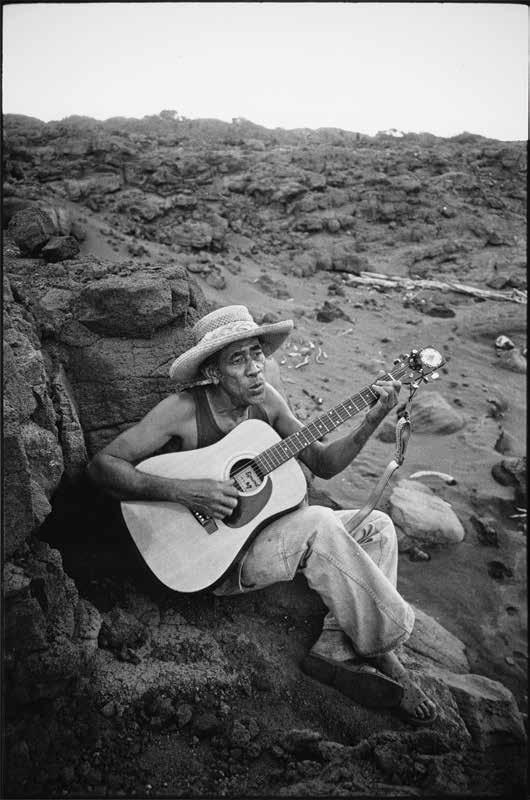
Harry Kunihi Mitchell was a mentor to the Protect Kaho‘olawe ‘Ohana. Shown here at Hakioawa in 1979, he sings “Mele o Kaho‘olawe,” which became the unofficial anthem of Protect Kaho‘olawe. Harry wrote the song after the disappearance of his son Kimo and George Helm, who were lost at sea in an attempt to rescue protestors believed stranded on Kaho‘olawe.
 Retrieved shell casings found during cleanup sweeps of the island by the Navy Explosive Ordnance Demolition Crew.
Retrieved shell casings found during cleanup sweeps of the island by the Navy Explosive Ordnance Demolition Crew.

Unexploded artillery shells are displayed on a jeep during a Navy search mission of the topside live fire area of Kaho‘olawe during early cleanup operations, circa 1993.
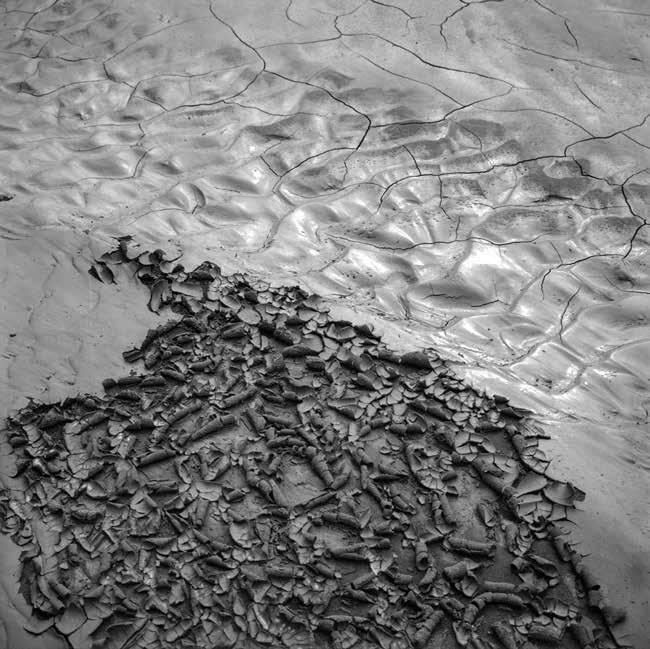
Each winter, southern storms bring life-giving rain to Kaho‘olawe’s grasslands. At the same time, upland soil erodes away, and red silt and mud from erosion is deposited at the shoreline. Photographed in 1993 near Hakioawa Bay on the east side of the island.
a reminder that, for decades, aho olawe was assaulted with an arsenal of military grade roc ets, guided missiles, bombs, grenades, and T T so e plosive it is believed to have crac ed the island’s water table.
On our rst afternoon on the island, after par ing our four wheel drive truc s at another ili to remove invasive waist high fountain grass, we cautiously stepped around a rogue pile of bullet casings and shrapnel. Multiply that scrap metal by million pounds, and you have the estimated amount of material removed from the island’s interior following the .S. government’s handover of aho olawe to the State of awai i. Only percent of the island has been surface cleared o cially called Tier . reas cleared an additional four feet below the surface Tier are considerably less, only about percent. ative plants, then, are critical to the island’s preservation, and to alleviating the dread of simply wal ing on the island’s surface. ecause volunteers are only able to plant them in the designated tiers, their presence also indicate you’re in a one that’s been deemed safe for passage, by car and foot. eing surrounded by these stone planters creates a mutual feeling of refuge. e protect the island, and the island, in turn, protects us. i e most sacred spaces, life and death’s dualities fold into their boundaries, often une pectedly. Someone concluded the planters resembled mini ahu, awaiian altars another whispered that they loo ed li e gravestones. e ept on stac ing until there were no stones left. enturies ago, aho olawe went by another name ohe M lamalama O analoa, or analoa, for short, an a ua of the ocean and one of the four ma or
awaiian deities. The island is one of analoa’s inolau, or bodily forms. ts reverence is carved into boulders at oa a, where petroglyphs that date bac years have been recorded. They are noted for their unusual and idiosyncratic aesthetic human figures with inverted, triangular heads bisected at the center. early half of aho olawe’s nown petroglyph sites house these styli ed head shapes detached, headless, or draped in headdress. rcheologists theori e they could represent huna or demi gods they could also be allusions to numerous royal ali i visits. The emphasis placed on these religious sub ects echoes the island’s enduring status today as a spiritual center. t seems that even when ancient awaiians were chipping away at stone to create the memorials, they were already consumed with the island’s effect on the human consciousness.
t’s better to let these p ha u, or roc s, spea for themselves. ven George elm, alter itte, oretta itte, oa mmett luli, and other aloha ina warriors whose personal writings were published in Na Manaʻo Aloha o Kahoʻolawe struggled with e pressing the island’s significance. The place was too heavy for words, many felt, which only inspired action. Man is merely the careta er of the land that maintains his life and nourishes his soul, elm wrote in a letter. Therefore ina is sacred. The church of life is not in a building, it is in the open s y, the surrounding ocean, the beautiful soil. elm and imo Mitchell whose father, arry unihi Mitchell, wrote Mele O aho olawe were lost at sea after an attempt to rescue protestors they believed were stranded on aho olawe. found this limit on language, against the limitlessness of the landscape, to
hat can write of is inship. This, felt in nearly every wa ing hour on the island, kneeling in the sand, dirt, and salt with the other volunteers.
As the exterior of Kaho‘olawe wears away, more and more unexploded ordnances and fragments surface— a reminder that, for decades, Kaho‘olawe was assaulted with an arsenal of military bombardments.
58 | FLUXHAWAII.COM

The akua loa, or banner of the god Lono, is carried across Hakioawa in 1987. The procession marked ceremonies and offerings celebrating the end of the Makahiki season. Through access to Kaho‘olawe, Native Hawaiian culture was reborn in the hearts and minds of many young Hawaiians.
 Flume from an old cattle ranch.
Flume from an old cattle ranch.
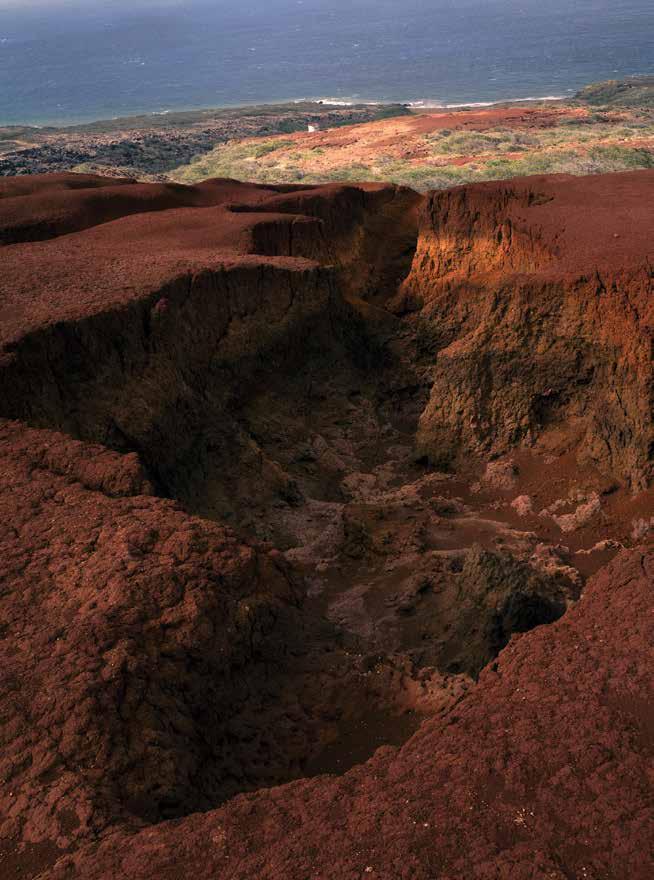 Major erosion above Hakioawa.
Major erosion above Hakioawa.
be a comfort. aving spent a mere weekend on aho olawe compared to its foremost guardians, the permanent aho olawe sland eserve ommission staff and independent members of the rotect aho olawe Ohana, people who’ve tirelessly devoted themselves to the island’s right to e ist in peace since the s feel admittedly foolish and incompetent to pontificate on its sacredness.
hat can write of is inship. This, felt in nearly every wa ing hour on the island, neeling in the sand, dirt, and salt with the other volunteers.
Side by side, we planted shrubs of a i a i, a
native grass, in the lowly sand dunes of ono ana i. n the late afternoon, we bodysurfed freely on the beach, our laughter and pearly grins floating on the whitewash. longside a tidepool, the eldest volunteer e tended to me the largest opihi ’d ever seen in my life, and the gesture itself felt li e its own ind of sacrosanct act. t sunset, a glow settled over our camp, where the grill si led with pulehu stea s. Our s in salty and bronzed, we sat in communion, loo ing across the ocean as its waves pulsed against the shore, and no one spo e. e ust listened.
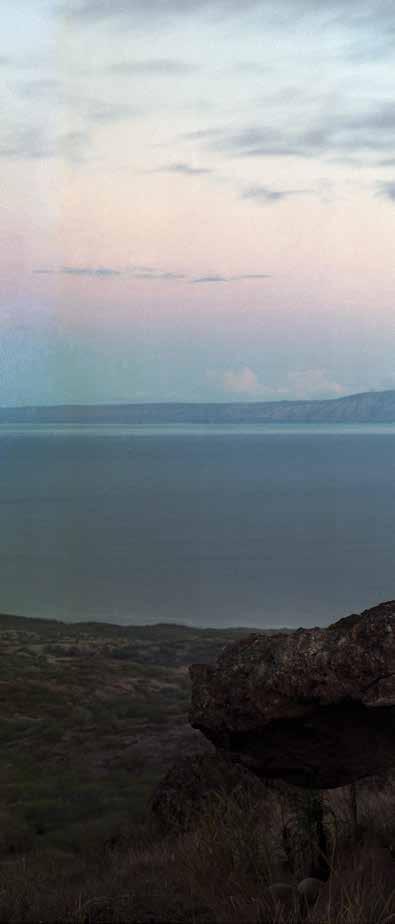
62 | FLUXHAWAII.COM
Crest of Moa‘ulaiki, looking toward the Kealakahiki Channel with L ā na‘i and Moloka‘i in the distance.


Curb Your Exposure
Social media has opened a window to the world. Its influential and eager users are left to wonder what impacts their online projections have on physical places, sacred and unseen.
TEXT BY BEAU FLEMISTER
Social media users, like Kaua‘i-born Chelsea Yamase, whose media account is a surreal gallery that depicts her in extraordinary natural spaces across the globe, are reexamining their impact on physical spaces. Image by Bryce Johnson.

FLUX FEATURE 64 | FLUXHAWAII.COM


Ihave a photograph of myself standing ne t to a pile of human s ulls. eep it tuc ed away within the plastic sleeve of a photo album deep inside my closet. n the picture, my arms are outstretched, as if to say, Get a load of this am wearing a bright yellow cap that reads ot hic s. t’s a confusing photo.
am no anthropologist. found myself in that specific place in time because, some years bac , had a fascination with the deep South acific. was obsessed with the cultures of Melanesia, the cargo cults and land divers of Vanuatu, the pre contact tribes in the highlands of apua ew Guinea, and the region’s peculiar, not so distant cannibalistic past.
The islands of Melanesia are big, but the guideboo s are slim. saved up a few grand by par ing cars and pounding nails, bought a multi stop tic et, and went there. visited villages in apua ew Guinea, where little children who’d never seen a white man too one loo at me and ran away crying. n the highlands, saw women whose faces were covered in intricate tribal tattoos. witnessed a circumcision ceremony on the island of Tanna in Vanuatu, and felt the ground sha e as boys from four villages marched in for the celebration feast. saw warriors with bows and arrows, children hunting giant fruit bats with slingshots, and it was all much more e otic and humid than could have ever dreamt.
On an obscure island in the Solomon slands, the morning after hunting for coconut crabs beneath the light of a full moon, a local guide led me along a trail, up a mountain that ended at a pile of s ulls. t was the shrine left behind by a cannibal
ing, he told me. long with do ens of human s ulls were bits of coral ewelry and a crocodile s ull. There were no other bones from the human anatomy. Just many, many s ulls.
do not now if there is a polite way to as a local man to ta e your photo in front of such a macabre and presumably sacred place, but he didn’t seem to mind my fumbling request. Click .
This was shortly before the dawn of Faceboo and the normali ation of sharing every moment with the world. uring my travels, was armed with only a cheap disposable camera. t wasn’t until after returned home from my ourney that printed the pictures at ostco’s photo center and then slipped the by inch prints into a leather album also bought at ostco, in a two pac , of course .
hen loo at that photo a decade later, the emotion that emerges is not nostalgia, but rather, shame.
Today, we’ve all seen the efects that social media can have upon a place. The dive bar loses its grime but gains men with top nots. Trails are eroded by a surge of visitors. istracted hi ers die. Secret beaches are unveiled and soon littered with trash.
hen spo e with arbara runo, a past president of the awaiian Trail and Mountain lub, she spo e of the impact of social media on O ahu’s environment. can certainly say that in the ’ s and most of the ’ s, the trails on O ahu were usually empty, she says. n the last decade, however, there’s been a dramatic increase. n the past, the point was to go hi ing, and then maybe you would share some photos that you too later. ut now, it seems li e Image by Tara Rock.
n the past, the point was to go hi ing, and then maybe you would share some photos that you too later. ut now, it seems li e it’s the sharing that is the central point of the e perience.
Barbara Bruno, former president of the Hawaiian Trail and Mountain Club.
66 | FLUXHAWAII.COM

it’s the sharing that is the central point of the e perience.
scapism has always been sought in society, but these days, social media users e hibit a sense of FOMO that’s a fear of missing out, for the socially obtuse li e never before. This plays out in our social feeds. e worship, follow, li e, and tap tap tap on the feeds of others who appear to be living the dream, those whose days are spent adventuring through cavernous valleys or piercing the ocean’s crystalline surface.
One such social influencer is athlete, model, and blogger helsea amase, whose nstagram feed chelsea auai is astonishing. amase’s more than , followers and counting view images of her lounging underwater on a bed of swaying sea grass, while a school of shar s circles above her somewhere off the coast of eli e. These followers double tap on pictures of her perched atop an obscure roc y pea overloo ing a valley on O ahu, or see her ushering in the dawn, posed at the gates of heaven above a volcano in ali.
ndeed, there are many nstagram accounts that resemble amase’s, all yelling triumphantly, am here, hear me roar amase’s fame, however, is not merely a result of smo e and mirrors.
aised on aua i by her father, a commercial fisherman and surfer, and her mother, a triathlete
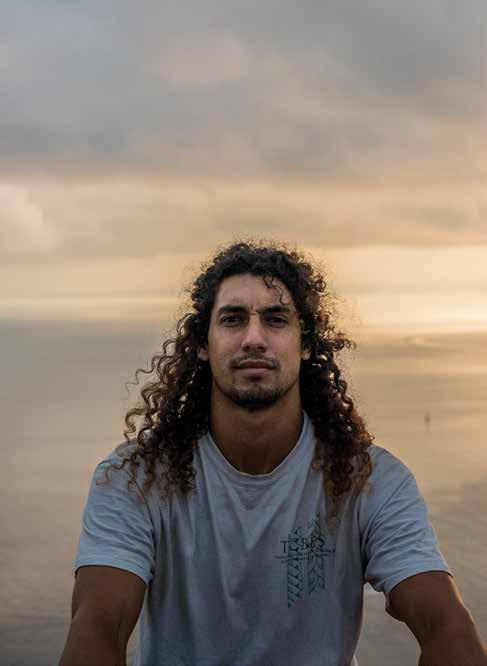
and equestrian, amase was reared as a land and sea outdoorswoman. She can freedive to a depth of feet on one breath and casually ogs across towering ridgelines.
Over the years, amase has parlayed this lifestyle into a personal brand of influence, and is she is now hired by companies
to produce, photograph, and often star in marketing campaigns that highlight a particular product.
don’t thin anyone can stop the spread of information about beautiful places, amase says. The nternet and social media are too good at disseminating information to really manage it
“Culturally, among Hawaiians, there was always permission, training, knowledge, and lineage required. There was always a purpose to explore,” says Clifford Kapono, who has been using analytical chemistry to investigate the impacts humans have on their environments.

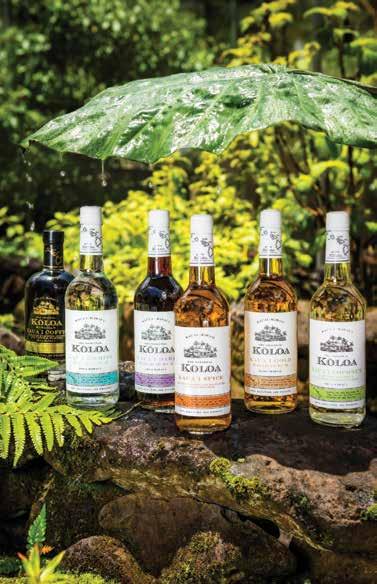






































GOLD 2016 SPIRITS COMPETITION



efectively. thin a better way to approach it is to create an environment of conscious outdoor users.
hile amase’s nstagram account is a surreal gallery that depicts her in e traordinary natural spaces across the globe, she strives to use her reach responsibly, educating viewers about environmental issues connected to the shot and prioriti ing environmentally conscious brands. amase has even developed a personal code of ethics that she follows for her social media presence, in an attempt to mitigate any potential damage her e posure could create. few points include
elete comments that mention the location of photo or strong hints to it, and if possible, private message whoever commented to e plain why.
Only post photos that follow eave o Trace recommendations i.e. not camping ne t to a water source .
o photos touching marine life or images that could be ta en as implying it’s O to chase after or swim intrusively toward them.
e used to educate and pass nowledge one to one, amase says. nd, in a way, it ept things much safer, because you would hi e with someone and they would teach you, ey, this area is special, these plants are sensitive, this is an ancient heiau.’ ow, it’s one person reaching hundreds of thousands of people, and there is immense power and responsibility with that.
lifford apono, a scientist, surfer, and independent filmma er, has been
e amining how social media’s e posure affects awai i from a scientific lens. urrently obtaining his doctorate in chemistry at the niversity of alifornia, San iego, apono uses analytical chemistry and genome sequencing tools to investigate the impacts humans have on their environments.
cross social media, we’re commonly encouraged to interact with nature, apono says. nd thin that’s fine and healthy, but we’re finding out what that interaction actually loo s li e on a microscopic level. For e ample, for his Surfer iome ro ect, funded by a grant from the San iego Global ealth nstitute, apono is traveling to five continents to study how the chemicals and bacteria on surfers’ bodies affect their environments on a molecular level, and vice versa.
’m not spea ing on behalf of all ative awaiians, but for myself, was brought up that we have boundaries, apono says. thin there’s a huge difference in perspective between the community of social media and the community of indigenous cultures.
The message of social media, apono e plains, seems more closely tied to a estern mentality to coloni e and conquer, be an adventurer, e plore the un nown, he says. ut culturally, among awaiians, there was always permission, training, nowledge, and lineage required. There was always a purpose to e plore. nd that purpose was only to maintain a balance in accountability and stewardship.
f we’re to be good stewards of the land in awai i where resources are in fact limited— then we should probably keep in mind what a photo connected to thousands of followers could do to a place, Tara Rock, the woman behind the popular surffashion blog Ladyslider. Image by Tyler Rock.
72 | FLUXHAWAII.COM
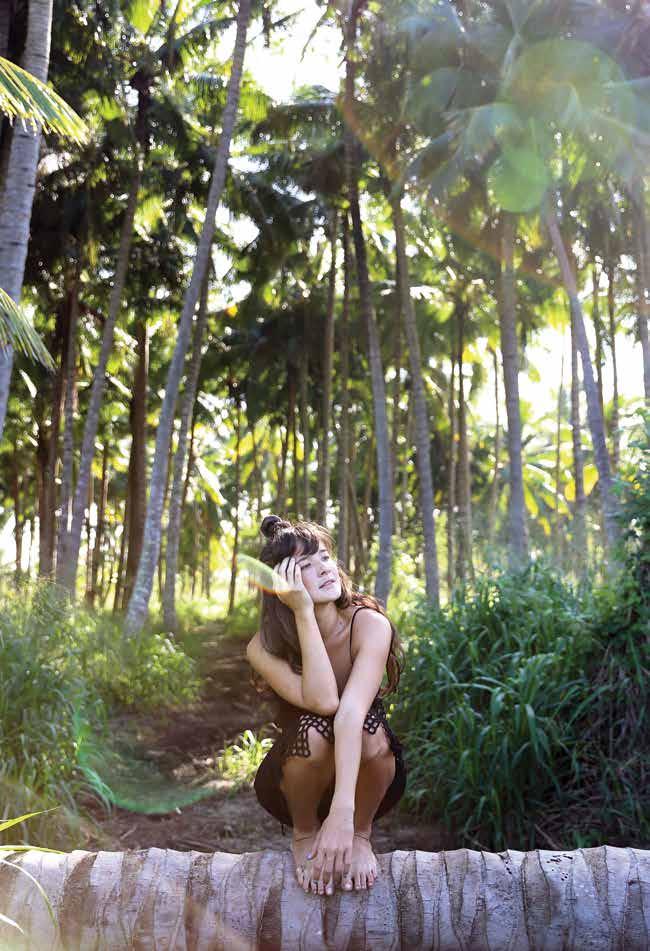
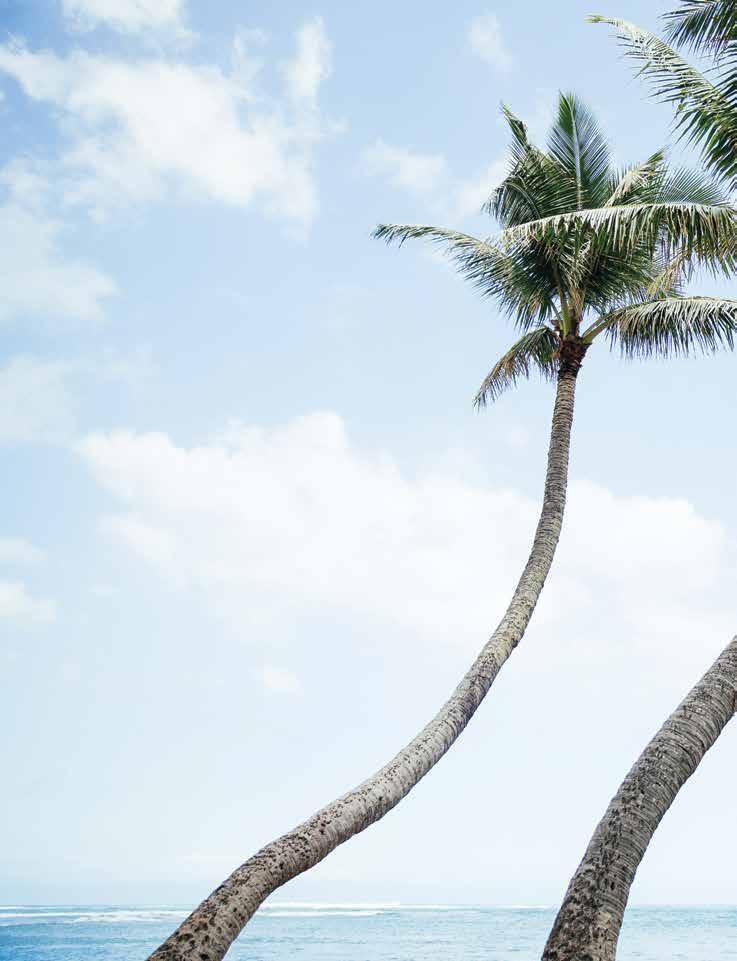 Image by Tara Rock.
Image by Tara Rock.


FLUXHAWAII.COM | 75
Tara oc , the woman behind the popular surf fashion blog adyslider, reassessed her social practices after tal s with apono. round two years ago, my wor started to feel ind of meaningless, says oc , who is hired to create fashion and travel stories for brands like Teva and loomingdale’s. More than pretty photos of a person in a place, I wanted to bring some sort of significance or purpose to every shoot did. Maybe the audience could even learn something about the place other than it being some static location.
In a poignant call to creatives in a blog post titled, Sacred laces, she questioned the way the social community herself included portrays and uses awai i in its wor or play. hen a company emails you as ing to wor on a campaign it is easy to compromise the people and places around you, she wrote online. ’m guilty of this. will shoot a lifestyle campaign at the e pense of a photogenic location. nd there is always some level of contrived imagery involved. So essentially, it’s not real.
Since this reali ation, oc has been more mindful of the impact of her wor . ecently, when Teva hired her to promote the release of a new shoe collection, Rock embarked on a camping adventure in ahana State ar on O ahu’s east side. er blog post, titled On eing a More onscious amper, cited a cursory review of local area history and listed environmentally friendly camping tips alongside adventurous photos of

her sporting Teva’s newest offerings. t’s a fine line.
f we’re to be good stewards of the land in awai’i where resources are in fact limited then we should probably eep in mind what a photo connected to thousands of followers could do to a place, she says. ust wanted to continue this conversation about people being more diligent with
the content that they’re sharing. thin we should be held more accountable.
Maybe we need to as ourselves, hat are we contributing to society ’ ou can have a million followers, but is that the legacy you’re going to leave
“I don’t think anyone can stop the spread of information about beautiful places,” says Chelsea Yamase, whose image is shown here.
“I think a better way to approach it is to create an environment of conscious outdoor users.”
76 | FLUXHAWAII.COM

FLUX FEATURE
In the Light
Residents of Hawai‘i Island find relief, spirituality, and successful business in mineral crystals.
TEXT BY LEʻA GLEASON
IMAGES BY JOHN HOOK

Protected by massive clifs, Green Sands each, the gleaming bay at the southernmost point of the nited States, emits hues of sage and citrine when the sunlight hits its sand. eralded for its beauty, and for the sense of peace it instills in those who visit its shoreline, this ig sland beach boasts a glimmering display of one of awai i’s most unique facets olivine. This translucent green mineral comprises percent of the arth’s upper mantle, but it is rarely seen on the planet’s surface. owever, olivine is plentiful on the ig sland, home to the world’s most active volcano, since the mineral surfaces with magma, crystali ing as the molten roc solidi es, and dislodging via erosion over time. t Green Sands each, where the weather and waves erode the encircling clifs, olivine crystals dot the beach in such plentiful numbers that the sand actually appears green. On this island of olivine, several residents have felt the calling of such mineral manifestations, and have become crystal collectors.
REFLECTING LIGHT
On the ig sland’s southeast coast, in the una district, waves lap energetically at the large roc s that, when molten, flow over the town of alapana. t the edge of the roc s, a new beach is slowly forming. earby, lava from alema uma u rater continues to pour into the ocean, putting on fiery displays for legions of visitors who travel by land and sea to catch a glimpse of the spectacle.
long the viewing path to the current fow stands an outcropping of tiny homes, where feet erode gravel paths and sweat drips down the brows of e cited tourists. ere, local resident erry ong tests boundaries of former e pectations
about the life he once had, eroding away unnecessary ideals and e panding his mind. The solitary man’s tiny home, low on Mauna oa, is easily recogni able. long the road to the lava sits a small shed with an image of ele, the awaiian goddess of fire, that was painted by local artist an Madsen. earby, a small platform lined with turf is mar ed with a sign inviting tourists to sit down and rest amid the sweltering, arid heat. Orchids and tree ferns that ong has tuc ed into lava niches offer pops of green where soil will eventually form in the crevices, aided by a little cinder, mulch, and the roots of the flourishing plants.
earby on the property sit two more structures one, a modest itchen the other, a tiny room with one ma estic purpose to house ong’s hundreds of crystals. The smaller among the cache are displayed in wooden cases with individual cubbies, while the larger hun s rest on tables and the floor. ong has been collecting crystals for three years, but it was nearly seven years ago when he says he first felt a calling to become more spiritually aware.
ong had been financially successful as a property manager in alifornia, and later in awai i, and was happy living what he called a material life. ut he felt there might be something more substantial to pursue. hile in awai i, ong sought advice from those around him, li e his acupuncturist. ut it was ong’s tattoo artist, who added a manta ray image in reverence to ong’s passion for canoe paddling to the blan et of tattoos covering his bac , who sent ong down the path to spiritual awa ening. Three days after getting inked, Long was paddling in Hilo ay when a large manta ray leaped from the water in front of his canoe.

get so many compliments from people saying they feel the energy coming out of this place more than before, says crystal collector erry ong.
In Kalapana on Hawai‘i Island’s southeast coast, Kerry Long’s crystal room helps him to test boundaries of former expectations about the life he once had, eroding away unnecessary ideals and expanding his mind.
80 | FLUXHAWAII.COM

The encounter left him feeling that there was rhyme and reason to everything happening in his life.
round that same time, ong says, his life began to change. olors flashed behind his closed eyelids, and the sound of Tibetan singing bowls would ring in his ears, despite his being nowhere near them. e began to e perience through feeling rather than nowing, and the feeling he found when he discovered his first crystal, he recalls, was magical and indescribable.
ong has never studied geology, or contemplated the metaphysical properties of crystals. ust loo at it and feel, and people tell me what they supposedly mean, he says of his crystal selection process. The pieces he brings into his home are always on display and sometimes held or worn around his nec on special occasions.
hile ong has spent most of his life in and around the water, at his tiny, crystal filled home amid miles and miles of barren lava fields, he see s to harness a new element fire. ong feels he was called to live in this particular home, ust miles
from the active lava flow, despite being afforded no insurance, should ele change her course. Still, he says it’s worth it to live in an area of such active creation.
n ong’s crystal room, a seashell curtain clin s softly as wind blows through the open window. Occasionally, beams of light catch one of the crystals, sending rainbows dancing throughout the room. One of his favorites among the gems is quart , which he has in many shapes and si es. One day, ong hopes to offer massage therapy in this room, where he feels the energy of the minerals will positively affect recipients.
Since purchasing the house and property, ong has come up with various improvements and pro ects, li e the mural of ele he commissioned to be en oyed by those hi ing to the lava. ong gets comments about it from tourists and residents ali e, some of whom have watched his property evolve over visits to the active lava flow. get so many compliments from people saying they feel the energy coming out of this place more than before, he says.
Though Long has never studied geology, or contemplated the metaphysical properties of crystals, he says the feeling he found when he discovered his first crystal was magical and indescribable.

82 | FLUXHAWAII.COM


REFRACTING MINERALS
own the slope of Mauna ea, tuc ed ust above ilo town in the aumana area, are two individuals who also love crystals as much as erry ong ora ndrews and ristof augher. ndrews is airy, mysterious, and sweet, while augher is patient, contemplative, and comparatively outgoing. oth are wildly passionate about mineral crystals. The couple run a booth at the owntown ilo’s Farmers Mar et, which is where they met years ago.
Originally, the duo set up shop to sell their ewelry made with mgambo seeds, which loo li e delicate velvet coated beads. ut now, at this booth and in their everyday lives, augher and ndrews are on a crystal ourney that began by chance and has now evolved into their current business, Shine rystals.
The couple began incorporating crystals into their creations when a friend, who happened to be a crystal dealer, gave augher a piece of orth arolina a e tulite that made augher feel a physical shift within his body. This acquaintance told augher that the a e tulite had been telling him it needed to come to augher, so he passed it along as a gift.
Once augher held the roc , he says, t was ust an immediate, overwhelming e perience for my whole body. hen that crystal got into my hand, it shot energy up into my left arm and then into my entire body.
t too augher, who was originally fascinated by the mineral components of crystals from a scientific perspective, a while to wrap his head around the e perience. There’s a density in the human mind that refuses to believe that’s real, he says. That’s a really big leap of faith for people, to say that they felt it. ou’ve now put yourself in a camp, pitted against the non believers. ut after this e perience, augher says he began to physically feel the effects of other crystals when he was around them, manifested in things li e better sleep quality or more vivid dreams. Similar shifts in awareness have been documented do ens of times by those involved with crystals, particularly by obert Simmons, a pioneer in the metaphysical, human facing properties of mineral crystals. onvinced about these effects, augher and ndrews began collecting crystals as a hobby. Soon, the couple began incorporating them into the ewelry they created. Today, they deal in both handcrafted ewelry and rare mineral crystals from around the world, and collate their e tensive personal crystal collection. They have also created proprietary groups of crystals based on how the stones interact, which they sell as pac ages. These organi ed groupings of crystals, according to augher, assist in attaining physical and mental wellbeing. They can also be laid out to create crystal grids geometric

to crystal distributors Cora Andrews and Kristof Baugher, the scientific properties of the minerals that make up crystals interact with the human body’s chemical composition and account for the feeling of energy.
patterns of crystals that help the user to focus his or her intentions and manifest quic er results.
Through their wor , augher and ndrews interact with massage therapists, rei i healers, and tarot card readers. istributing crystals is delicate wor , since the end users can be quite sensitive. The couple says that they have become attuned to the effects of various crystals, and find themselves halfway between the science camp and the metaphysical camp.
ccording to augher, the scientific properties of the minerals that ma e up crystals often light al ali ing metals, li e beryllium, strontium, or rubidium interact with the human body’s chemical composition and account for the feeling of energy. ealers who use crystals choose those that they believe aid them or their clients in physical, mental, and spiritual wellbeing, with effects ranging from lowered stress to increased ease in the brea ing of bad habits.
84 | FLUXHAWAII.COM
According

’m into the really powerful crystals, the metaphysical roc stars that have very rare chemical compounds, says augher, who favors phenacite, moldavite, and rhodi ite. ccording to him, these crystals can ma e a person feel more aware, alert, and alive.
e adds, ora is into the ones that are very calming and meditative and either contain lithium or have soothing qualities which nurture the soul. These include un ite, auralite , and quart . The pair li es to sit and rela with their crystals nearby. Sometimes they hold them, meditate while holding them, or even sleep with them.
On the other hand, the business side of Shine rystals requires not spending too much leisure time with the minerals they plan to sell. nstead, augher and ndrews match clients with the right crystals for each person’s unique and individual needs, listing the loo , feel, and beneficial qualities of each crystal carefully on their website for the public to see. ccording to the couple, many of the crystals they sell are rare, all of which were specially sought out for clarity, origin of location, and chemical composition.
Our clients are super e cited to feel the energy of something they haven’t e perienced yet, augher says. e were in the e act same position, saying , O ay now gotta try this

one ’ ou’re waiting for the mail to come so you can feel the energy of this crystal and see where that ta es you in life. t’s this beautiful unfolding.
“There’s a density in the human mind that refuses to believe that’s real,” Baugher says. “That’s a really big leap of faith for people, to say that they felt it. You’ve now put yourself in a camp, pitted against the non-believers.”
86 | FLUXHAWAII.COM

 Waikolu Valley on Moloka‘i. Image by Jeff Hawe.
Waikolu Valley on Moloka‘i. Image by Jeff Hawe.
EXPLORE

“I
don’t think you have to be a Christian or a Buddhist or a Native Hawaiian or an astronomer to appreciate … and experience the moments that other human beings feel are sacred.”—Jessica Terrell

Exiling Ghosts of the Past
With just 13 patients left in Kalaupapa on Moloka‘i, island residents are left to contend with the remote area’s uncertain future.
TEXT AND IMAGES BY JEFF HAWE
long the mile northern shore of Molo a i, towering sea clifs reach , feet into the s y. n their shadow is the alaupapa eninsula, barely ve square miles in total, which on most days feels tranquil. n contrast, its roc y coastline is largely inaccessible even by boat, since the aci c surf pounds it relentlessly.

The steep valleys e tending inland from the crac s of these fortress li e walls are sparsely inhabited. The beaches that front the peninsula, comprised of sand both blac and white, imply paradise. owever, most who now the history of the area, and how it served as a place of banishment for many island residents, know life here wasn’t always so serene.
For years, ative awaiians resided on the alaupapa eninsula, and in the connecting ai olu Valley. The land was divided according to the traditional ahupua a, consisting of three sections alaupapa to the west, Ma analua in the center, and alawao on the eastern side of the peninsula. stimates place the population between , and , at its pea . rchaeological evidence indicates that these small communities thrived, cultivating the land, gathering natural resources, and trading. owever, in the s, estern contact and disease decimated the inhabitants here, as well as in other areas of awai i. y , only about awaiians were left in alaupapa.
The northern coastline of Moloka‘i is largely lined by cliffs abutting the sea. Among them them is the 5-square-mile Kalauapapa peninsula.
90 | FLUXHAWAII.COM
EXPLORE | MO O

“Even if they sent us here ... look around,” says Norbert Kaiama Palea, who was exiled to Kalaupapa in 1947 at the age of 5. “They gave us the most beautiful home in the world.”
THECURRENTOFHAWAII.COM | 91
n , ing amehameha V passed n ct to revent the Spread of eprosy, banishing anyone diagnosed with ansen’s disease, better known as leprosy, to the remote peninsula. The disease was spreading across the islands, ta ing an especially brutal toll on the awaiian population, who possessed few immunities to disease. ith no nown cure and very little understanding regarding it, isolating those afflicted seemed the safest resolution. The oard of ealth, which amehameha V organi ed, acquired lands on the eastern portion of the peninsula in alawao, transferring the sic to this area and moving the remaining healthy inhabitants to the western side.
n , the first patients were dropped off in alaupapa nine men and three women. fter our names, ages and places we hailed from were ta en down, we were left on the roc y shore without food and shelter, patient mbrose T. utchison wrote, according to the ational ar Service, describing his arrival to alaupapa in . o houses provided by the then Government for the li es of us outcasts. The idea was that this collective would occupy the houses left behind by original inhabitants and cultivate the land for food. owever, most patients became too ill to work or even care for themselves. aving been torn away from their homes and left in an isolated, inescapable place to die, many simply gave up.

n , awaiian high chief and politician eter a eo wrote of life in alaupapa to his cousin ueen mma eaths occur frequently here, almost daily. apela last wee rode the beach to inspect the lepers and came on to one that had no oi for a wee but managed to live on what he could find in his hut, anything chewable. is legs were so bad that he cannot wal . y this time, there were people in alaupapa, and the quarantine had become a medical catastrophe. eports of the deplorable living conditions reached onolulu, and abroad. t was during this time that Father amien, a atholic priest from elgium, began wor ing to improve conditions for the a icted. ith aid from ing unalilo and ing al aua, amien established a rudimentary hospital and basic housing on the
peninsula, but after years of unwavering service, the clergyman passed away as a result of contracting ansen’s disease.
y , the population had grown to more than , . To avoid a humanitarian crisis, the oard of ealth began e tensive pro ects. cquiring the remainder of private lands in the area, they moved the last healthy inhabitants of the western side of the peninsula, and transitioned the a icted to where the present day settlement e ists today in alaupapa. rastic improvements in housing and medical facilities were made in alaupapa, and activities and sports were incorporated. n , the cure for ansen’s disease was discovered, and in , the quarantine law, which had e iled more than , people, was revo ed. atients were now free to
leave alaupapa. et many remained. The place that had once been a prison had become a sanctuary. e have all these great leaders here, said orbert aiama alea, who was e iled to the area in at the age of , in an interview that aired on S awai i in . ven if they sent us here loo around. They gave us the most beautiful home in the world.
alaupapa ational istorical ar was established in in order to preserve the area’s history and culture. These days, the peninsula e ists as a place of refuge for the last remaining patients, numbering in total, the youngest of whom is . Tal among residents often revolves around ero patients, regarding what will happen to the area when all patients have passed on. Still, more than , people are buried in alaupapa, although
92 | FLUXHAWAII.COM


Follow us @fluxhawaiitravel
only about , graves are mar ed.
The future plan for alaupapa remains undecided. The land, which is managed by the awai i State epartment of ealth, will eventually be turned over to the ational ar Service, managed in con unction with the state and the epartment of awaiian ome ands. ut public access to the peninsula and its resources remain up in the air. The ational ar Service has developed four strategies for managing and protecting the par to years into the future. The most conservative of these ma es few changes, leaving access largely as it remains now, which is limited. The most radical strategy opens alaupapa, giving visitors opportunity to e plore and e perience it unrestricted. The ational ar Service has e pressed a preference for a strategy for access that falls somewhere in the middle, opening the par to visitors to participate in stewardship activities and educational e periences. This option would also allot unstructured e ploration of the peninsula in limited ones, and overnight camping on an approved, permit basis.
The main goal now is to protect alaupapa and its resources, preserve its stories and built environment, and conserve the range of natural resources, said ri a Stein spaniola, the
par ’s superintendent, in an email. long term goal is to provide meaningful opportunities for people to learn about and e perience alaupapa. e want to provide the space for people to have a reflective e perience. The transition will happen slowly, with a lot of care and monitoring to ensure the specialness and sacredness of alaupapa is maintained.
a Ohana O alaupapa, a nonprofit organization dedicated to promoting the value and dignity of all e iled individuals, has wor ed to preserve the story of alaupapa. The group helped to get federal legislation signed by then resident arac Obama in for a memorial to list the names of all the e iled. The memorial, in discussion since the mid s, is now in the planning and design stage. The organi ation has also done e tensive outreach to connect the families of deceased alaupapa patients to their lineage of ancestors.
egardless of what happens, it is imperative that lessons of the past inform actions of the future. Maybe there is no ero, says Sol aho ohalahala, a founding member of a Ohana O alaupapa. There is only ohana. e need to ma e sure the voices of alaupapa are heard, even if the people are not physically with us anymore.
“The main goal now ... is to protect Kalaupapa and its resources, preserve its stories and built environment,” said Erika Stein Espaniola, the park’s superintendent.
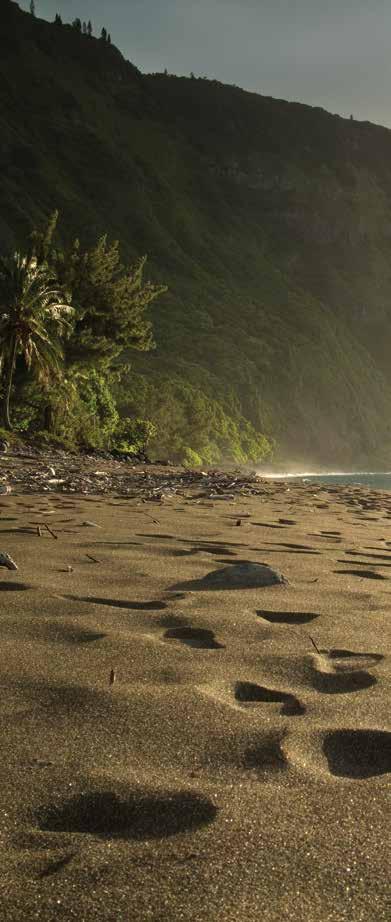
94 | FLUXHAWAII.COM


FLUXHAWAII.COM | 95
WHY NOW IS THE PERFECT TIME TO VISIT HAWAII

You want more than just a vacation. You want to embark on a journey to a place of discovery, picturesque views and memorable experiences that will last a lifetime. At our 12 distinct resorts on four Hawaiian Islands, we invite you to experience your version of paradise.


Personalized Relaxation
Get back to your best self with Moana Lani Spa, Waikiki’s only oceanfront spa located at the legendary Moana Surfrider, A Westin Resort & Spa. From Hawaiian healing traditions to signature rituals to inspire the spirit, their spa services will leave you feeling refreshed and energized. The Lomi Lomi Ola is the island’s traditional massage and Lomilomi practioners are trained with Kumu (teachers) whose lineage are from “kahuna Lomilomi,” the healers of body through massage. moana-surfrider.com
Majestic Manta Rays
Manta rays can be viewed year-round off the Big Island’s Kona Coast. Sheraton Kona Resort & Spa offers the best location to witness these graceful and hauntingly beautiful gentle giants. Its signature restaurant, Rays on the Bay, features a special viewing area to observe manta rays while sipping cocktails and enjoying the best of Big Island cuisine. For the ultimate experience, snorkel the waters of Keauhou Bay to see the manta rays in their natural habitat. sheratonkona.com
ADVERTISEMENT


More Luxury. More Destinations.

Location, location, location
From Princeville and Waikī kī to Ka‘anapali and Kona, you’ll find the perfect destination for your next Hawaiian getaway. Choose from our collection of 12 distinctive resorts on the islands of Kaua‘i, O‘ahu, Maui and Hawai‘i Island and book our Ocean Promotion Plus Package to enjoy daily breakfast for two and savings on nightly rates, including premium Ocean View rooms.
TO LEARN MORE, VISIT OCEANPROMOTIONHAWAII.COM OR CALL 866-716-8140 AND MENTION OCEAN PROMOTION.



 KAUA‘I MAUI
O‘AHU
HAWAI‘I ISLAND
LEFT TO RIGHT: THE ST. REGIS PRINCEVILLE RESORT; MOANA SURFRIDER, A WESTIN RESORT & SPA; SHERATON MAUI RESORT & SPA; SHERATON KONA RESORT & SPA AT KEAUHOU BAY
SHERATON WAIKIKI, WAIK Ī K Ī BEACH, O‘AHU
©2017 Marriott International, Inc. All Rights Reserved. Starpoints, SPG, Preferred Guest, Sheraton, Westin, St. Regis, The Luxury Collection, W, Le Meridien, Design Hotels, Tribute Portfolio, Element, Aloft, Four Points and their respective logos are trademarks of Marriott International, Inc., or its affiliates.
KAUA‘I MAUI
O‘AHU
HAWAI‘I ISLAND
LEFT TO RIGHT: THE ST. REGIS PRINCEVILLE RESORT; MOANA SURFRIDER, A WESTIN RESORT & SPA; SHERATON MAUI RESORT & SPA; SHERATON KONA RESORT & SPA AT KEAUHOU BAY
SHERATON WAIKIKI, WAIK Ī K Ī BEACH, O‘AHU
©2017 Marriott International, Inc. All Rights Reserved. Starpoints, SPG, Preferred Guest, Sheraton, Westin, St. Regis, The Luxury Collection, W, Le Meridien, Design Hotels, Tribute Portfolio, Element, Aloft, Four Points and their respective logos are trademarks of Marriott International, Inc., or its affiliates.
In the Heat of the Moment
A day in a sweat lodge makes for heated moments and spiritual cleansing.
TEXT BY RAE SOJOT
IMAGES BY LILA LEE
hat happens if it gets too hot as ed the intercessor. Though was eager to participate in my rst inipi, or sweat lodge, I was an ious about the heat. ou pray, he replied. ith a nervous chuc le, ne tuned my inquiry. et’s say it gets really hot, pressed. i e, unbearably hot. hat happens then is face shone ind and sincere. Then we will pray for you.

Stretching bac thousands of years, the inipi is a ative merican prayer and purification ceremony that remains a vital spiritual tradition among tribes today. n the a ota language, inipi means to live again, and for those ta ing part, the sacred ceremony offers a spiritual rebirth. e try to wal the ed oad, the intercessor said. The intercessor would be guiding the inipi, hewing to the traditional a ota Siou teachings he credited to elder Sidney eith, who led the sun dance at the heyenne iver eservation. Symboli ing humility, generosity, respect, and indness, the ed oad represents the path of our best selves and the goodness of the world, e plained the intercessor, who is so named because he intercedes on behalf of participants to realign them with the Great Spirit. emaining on this road, however, is challenging, he continues. e fall or stall or choose to wal in another direction and so our world suffers. y offering communion with ourselves, our ancestors, and the Great Spirit, the inipi helps to realign participants with their true and rightful paths. See ers
Preparations for the inipi, a Native American prayer and purification ceremony, involves participants creating prayer ties and building a lodge.
98 | FLUXHAWAII.COM
EXPLORE | O

pray for guidance, assurance, and clarity. Gratitude is given. t is when we give of ourselves, we can help others, said the intercessor. The world suffers less.
The morning of the inipi, the s y shone a brilliant blue. s wal ed to the ceremonial grounds ensconced in the o olau mountains, gave myself a pep tal . emain open you are braver than you thin . wasn’t sure what drove my nervousness. erhaps it was the e perience’s physical demands. hen as ed how hot the lodge would be, the intercessor answered, hot enough. nternet sleuthing revealed temperatures could rise well into degree Fahrenheit territory. Or perhaps it was the navigation of an un nown spiritual landscape. ould the Great Spirit view me as a mere interloper Or worse, someone misappropriating the tradition as some sort of spiritual vanity pro ect t the site, a young man pivoted heavy logs upright into a fire pit, while a woman placed flowers and sage bundles onto a sun bleached
buffalo s ull. eople moved about in ceremony preparations with a serene purposefulness. earby stood the lodge, a low domed structure crafted from strawberry guava wood branches and bound together with strong twine. t its top, the boughs created a star shaped window open to the wide s y above.
few feet away, a small group of men and women placed pinches of tobacco into small squares of colored cloth and tied them closed with sinew. These were their prayer ties, to be hung inside the lodge. The colors of the cloth held meaning, learned blac for the west, and courage and faith red for the north, and strength and fortitude yellow for the east, and wisdom and nowledge white for the south, and compassion and forgiveness. Father S y, the giver of clarity and discernment, was represented by scraps of blue. Mother arth, for nurturing and healing, was green. ach person’s prayer tie was different, the colors chosen for their specific prayers.
n the shade of a low tree, the intercessor, who would be guiding the ritual, prepared his ceremonial implements with methodical reverence. e passed a long stem pipe and a rawhide drum from hand to hand through sweetly scented smo e. Sage, a woman in her mid s e plained to me, pointing to some dried material smoldering in a small metal pot. Tall and graceful, Jen had been attending this inipi for five years. Sage is often used in ative merican cultures as a purifier, she said. e watched as the intercessor coa ed tendrils of smo e around a staff adorned with eagle feather ties. e closed his eyes, and softly chanted a prayer to the reator.
earby, a re bla ed in the midday sun. nside the fames, obstructed from sight, were the chosen stones that carried the medicine for our hurts and messages from the spirits. They would be brought into the lodge via the Spirit ine, a trail of loose tobacco placed on the grass, connecting the re to the
THECURRENTOFHAWAII.COM | 99

lodge. Tobacco, li e sage, is a central ceremonial plant for the inipi. Spirits are especially attracted to tobacco, Jen said. urning it lifts our prayers up. s a group, we wor ed to enclose the lodge, layering on heavy canvases cloc wise, until light could no longer penetrate its interior. e gathered around the entrance, each of us smudged by aromatic sage smo e to rid of any negative energy clinging to us. Jen passed me a sprig of sage. Tuc it behind your ear, she whispered. t encourages the spirits to tal to you. The intercessor instructed the women to enter first and the men to follow. hen it was my turn, he placed a reassuring hand on my shoulder. ou will be fine. There are good people here to ta e care of you.
drew in a sha y breath and nelt. On my hands and nees, crawled across the threshold. nside, the lodge was dar and already warm. The ceremony would go four rounds,
or doors, the length of each round determined by the intercessor. fter each round, the entry flap of the lodge would be opened for a brief interval. nside, we sat cross legged and watched as si stones representing the four cardinal directions and Father S y and Mother arth were placed into the lodge’s roc lined pit. They emanated invisible waves of heat. eads of moisture formed on my chest and forehead. lose the door, the intercessor ordered.
Suddenly, we were sheathed in total dar ness. Fighting a rising tide of panic, tried to get my bearings. was in a lodge with other people, but could see no one. could only hear and feel. focused on the intercessor’s steady voice. whip of wind passed over the lodge, and suddenly two pric s of light appeared on the ceiling, li e little glowing eyes peering in. hh, it’s oyote, the intercessor remar ed. oyote is a tric ster in a ota mythology. e laughs during
serious times and scofs at the reverent. ad he come to moc us Me
The intercessor sprin led dried wild celery root onto the stones, producing a momentary flash of glittering red. e began to sing a welcome, and others oined in, their voices ebbing and flowing in the lilt of the a ota song. The beating of a drum reverberated against the walls. s the intercessor poured water onto the stones, they si led and hissed. illowing clouds of steam swelled. The change of temperature was instant and meteoric. was immediately drenched in sweat. orse, couldn’t breathe the rapid rise of heat and steam cho ed my airways. My heart raced. My mind raced faster. The intercessor and others seemed far away, their song li e a distant echo. concentrated on suc ing in quic breaths of air. began to cry silently, a torrent of tears streaming down my face. t was li e a roc had been dislodged from
100 | FLUXHAWAII.COM

FLUXHAWAII.COM | 101
a spring, releasing a flood of emotion. elpless and feeling every second as an eternity, began to pray. Open the door, the intercessor finally called out. elief and light swept into the lodge on a bree e. could see again. veryone glistened with sweat. Jen, seated ne t to me, as ed if was O . don’t thin can do this, said. This was harder than imagined. ould it be bad if left the lodge and came bac the ne t round Jen studied my tear strea ed chee s. o you really need to leave she as ed. new she wasn’t waiting for an answer. t was a question needed to as of myself. dropped my head. hy was crying That’s Grandmother’s presence, Jen said. The lodge is li e a return to the womb, and for many women, it is a reconnection with that lost feminine power. omen often cry during the inipi. llow that energy in and release your suffering . lose the door, the intercessor commanded anew. loo ed at Jen and the intercessor, and nodded. Gathering my strength, prepared myself for the following three rounds. ours, days, years what seemed li e lifetimes later, emerged from the inipi and into golden light of the late afternoon. Soa ed in sweat and e haustion, had lasted through the entire four doors. ou will be a different person from the one you had been prior to the inipi, the intercessor had told me. e was right.

felt cleansed. spiritual chord had been struc , its power resonating from the depths of something didn’t understand, but could only feel. O Mita ue O’yasin, all my relations am told the a ota say. e are all connected.
turned my face s yward and felt the wind pass over me, wondering if it was the breath of the ancestors having traveled across the plains and oceans to where now stood. nhaling deeply, turned to face the ed oad, feeling blessed.
102 | FLUXHAWAII.COM

on view through July 30 Shahzia Sikander (American, born Pakistan 1969) Parallax, 2013 (detail) Three-channel HD video animation, Audio Surround 5.1, music by Du Yun Courtesy of the artist 900 S Beretania St 808.532.8701 honolulumuseum.org This exhibition is made possible by the generosity of Sharon Twigg-Smith. Hospitality sponsor HALEKULANI Media sponsor Special thanks to Sony Hawaii Company, Sony Electronics Inc.

Between Heaven and Earth
In Ofshore, a podcast by Civil Beat, one reporter travels across the country to document what happens when indigenous values clash with industrial pursuits.
TEXT BY BRITTANY LYTE
IMAGES
COURTESY OF CORY LUM, CIVIL BEAT
Standing at the rim of lauea aldera, reporter Jessica Terrell cannot see the molten lava that has been continuously erupting for the last years. ut she can hear it churn and gurgle beneath her feet as it flows through the volcano’s sun en magma chamber.
On this windy winter afternoon, Terrell has accompanied ua ase, a awaiian cultural practitioner, to the home of ele, the volcano deity, to as for solidarity in the face of dissenting groups. ase is see ing strength in opposing the construction of the Thirty Meter Telescope on Mauna ea, a , foot mountain on awai i sland, where, according to awaiian spirituality, the gods dwell at the intersection of s y and summit. She is also as ing for divine reinforcement in the resistance against other pro ects across the nited States that call for things
like pipelines or copper mines to be built on land and water considered sacrosanct by native peoples.
Terrell is the host of Offshore, a podcast produced by onolulu news site ivil eat and , the nation’s largest public radio distribution mar etplace. For it, she e plores stories from awai i that offer insight into broader social issues playing out across the nited States. n its inaugural season, Offshore charted the influence of racial unrest in two onolulu illings set years apart. The show’s current season investigates the clash between science and culture in the debate over the construction of the Thirty Meter Telescope, or TMT, on Mauna ea. t also delves into a bid by ative awaiians to reclaim the meaning of aloha, and what happens when there are conflicting interests in lands that are culturally regarded as sacred, yet
104 | FLUXHAWAII.COM
EXPLORE | S

While Maunakea is a sacred site to many Native Hawaiians, it is also viewed as a sort of interplanetary Eden by some astronomers, who revere the mountain as a gateway to ancient galaxies and billion-year-old stars.
THECURRENTOFHAWAII.COM | 105 Created in partnership with Civil Beat.

scientifically deemed to be the best in the world for astronomical e ploration.
On her ourney to tell the story of awai i’s tallest mountain, Terrell was invited to witness intimate, sometimes spiritual moments in places that her sources considered holy. hile Mauna ea is a sacred site to many ative awaiians, it is also viewed as a sort of interplanetary den by some astronomers, who revere the mountain as a gateway to ancient gala ies and billion year old stars. The conflict between preserving the sacred and seeing new intergalactic frontiers is complicated by the do en other telescopes already littered across the mountain’s slope, as well as the treacherous history of land grabbing in awai i.
The reporting process also too Terrell to Oa Flat, ri ona, to land that is considered sacred to ative mericans at
the San arlos pache ndian eservation. ocated on top of one of the world’s largest copper deposits, the land is highly desired by an international mining corporation. n a rugged ravine dotted with petroglyphs, Terrell watched as mas ed pache men wearing body paint and elaborate wooden slat headdresses performed a crown dance. ccording to pache religion, the dance was given to the tribes by mountain spirits in order to facilitate healing.
o cameras or recording devices were permitted in the audience, which included members of other indigenous groups fighting their own land battles. s the pache danced, members of the Standing oc Siou Tribe and the ava o ation stood strong and silent alongside.
s a reporter, it’s not my ob to ma e a udgment on who’s right or who’s wrong, or whether these are truly sacred spaces,
At Maunakea, like near Standing Rock Indian Reservation in North Dakota, indigenous protestors came into conflict with police forces.
106 | FLUXHAWAII.COM

FLUXHAWAII.COM | 107
A Maunakea protector protesting the Thirty Meter Telescope is confronted by employees of the Hawai‘i Department of Land and Natural Resources.




Terrell says. ut don’t thin you have to be a hristian or a uddhist or a ative Hawaiian or an astronomer to appreciate being able to be there and e perience the moments that other human beings feel are sacred.
ac at the edge of lauea aldera, ase stands to face a thic billow of smo e pouring into the s y from the depths of the crater. Set beside her on the blea , lunar li e crust of earth that conceals the lava is a bundle of native plants and a nip of liquor. ase believes that when you as ele to ta e on a heavy burden, you should offer her a spot of gin to wash your request down. Tuc ed in ase’s palm is coal, a remnant from a fire that burned at an encampment at the unction of the Missouri and annonball rivers near the Standing oc Siou eservation. ase traveled there to protest the a ota ccess ipeline
alongside indigenous peoples from around the nation. ow, she raises her open hand above her head and lends her quivering alto to a awaiian chant. Gusts of wind push and pull at her dar , hip length hair. Though ase cannot see ele, she nows the deity is there in the fiery pit of the volcano, and among the indigenous movements aiming to protect the sanctity of native lands.
Last year, Pua Case and other Native Hawaiians traveled to North Dakota to join indigenous peoples from around the nation in protesting the Dakota Access Pipeline.
110 | FLUXHAWAII.COM

Beyond the Beach
A Hawai‘i woman living in Australia seeks the diversity of Sydney’s suburbs.
TEXT BY TINA GRANDINETTI
IMAGES BY ASH GOWAN
month after moved to ustralia, when was on the tram in Melbourne, a man in his early s hurled a racial slur at me and told me to go bac to where came from. ustralia, he said, was full, then cac led with satisfaction. aving grown up as a biracial woman of O inawan and uropean descent in

awai i, was accustomed to my bac ground being normalized, even privileged. This was my first e perience of outright racial abuse. had no clever retort, no scathing comebac . ust sat there, stunned, my heart beating in my throat.
n the two years since, this memory has lingered. s onald Trump gained power in my home country across the acific, the One ation arty, a far right relic from the s, clawed its way bac into ustralia’s political scene. Though One ation holds the support of only percent of ustralian voters, the party’s raciali ed discourse foments enophobia, contributing to a creeping feeling that if you don’t look or speak a certain way, you are not wanted in ustralia.
ut despite One ation’s inflammatory politics, nearly one third of ustralians were born overseas, and ussie culture, if there is such a singular thing, is far more than beach blonde surfers throwing shrimp on the barbie. ustralians, it turns out, don’t customarily use the word shrimp, preferring prawn instead. So, when my second visit to Sydney coincided with a wee end long storm, I decide to postpone trips to the beach and the Opera ouse, and instead see the diversity of Sydney’s suburbs.
On my first morning in the city, board a
112 | FLUXHAWAII.COM
EXPLORE | S

Along
THECURRENTOFHAWAII.COM | 113
Sydney’s coastline from Bondi to Coogee, rugged sea cliffs give way to spots popular for surfing and sunbathing, like Tamarama Beach, left, and Bondi Beach’s Icebergs Pool, above.
train headed west. ach stop brings a new wave of people that embar , and slowly, the scenes outside my window begin to change. S yscrapers give way to new build apartment blocks, which give way to single family homes and small fish and chip shops. ventually, the train pulls up to abramatta, home to ustralia’s largest Vietnamese community.
abramatta sits well within the bounds of Sydney’s sprawling suburbs, but it feels li e a different world. Outside the train station, on the footpath leading to the central mar ets, elderly men and women sit on milk crates, selling bitter melon, water spinach, and choy sum from their gardens. buy xôi from an old woman with withered hands and carefully unwrap its banana leaf covering to reveal a stic y rice ca e sweetened with steamed banana.
nside the mar et buildings, stalls are pac ed with produce, seafood, dry goods, and bootleg V s. The unmista able rhythm of commerce pulses merchants herald their wares, customers haggle over prices in a cacophony of Vietnamese, Thai, and ao. lmost none of it happens in nglish. n abramatta, nearly percent of residents were born outside of ustralia, and only percent of households spea nglish at home.
Vietnamese refugees began to settle in this suburb in the s, ust a decade after the official end of the hite ustralia olicy, which restricted immigration of non white

people. t first, the public was sympathetic to the plight of refugees escaping ommunist Vietnam. ut in the early ’ s, racism toward Asians began to intensify, as changing demographics transformed neighborhoods li e abramatta into ethnic enclaves that challenged the dominance of nglo ustralian culture. Such aversive attitudes were deepened by news of a growing heroin epidemic and organized crime networ s in the area.
auline ee anson, a first time political candidate with a trac record of outspo en hatred toward Aboriginal people, umped on the opportunity to harness these attitudes in service of her anti multiculturalism agenda. In a now familiar act of alchemy, anson, who went on to found the One
ation arty, transmuted the racial an iety of the white wor ing class into political momentum by railing against Aboriginal land rights and sian migration. believe we are in danger of being swamped by sians, anson said in her maiden address to arliament in . er policies would e plicitly advocate for an end to Asian immigration and the abolition of multiculturalism. ut hard times in abramatta were answered with equally hard wor , and many refugees became councilmembers and politicians, securing the social services and resources needed to lift up their communities.
Gradually, the Southeast sian community planted roots in ustralia, and the hysteria surrounding sian communities dissolved.
One ation lost its footing in national politics, and for two decades, most of the country came to see the party as an unfortunate political accident.
After browsing market stalls, ma e my way into the main food court and order a steaming bowl of n . eads of red chili oil swim through the broth. eside me, two second generation Vietnamese teens work their way through heaping plates of food from the Thai stall nearby, and two white women from the nearby salon sit with their heads wrapped in plastic wrap, slurping down ph ó while waiting for their hair color to set.
Si miles from here, and only miles from Sydney’s center, lies uburn. i e that of abramatta, most of this suburb’s population was also born overseas.
114 | FLUXHAWAII.COM

Cabramatta sits well within the bounds of Sydney’s sprawling suburbs, but with its busy market stalls and vibrant Southeast Asian cultures, it feels like a different world.
FLUXHAWAII.COM | 115

ere, epalese grocery stores sit beside lively ebab shops, hinese restaurants, and bubble drin stands. ut out of uburn’s familiar landscape rises a wide blue dome adorned with stained glass and flan ed by two towering minarets. This is the uburn Gallipoli Mosque, built lovingly by the Tur ish community in the image of stanbul’s lue Mosque. t draws more than , people each Friday for jumu’ah , or Friday prayers. n its early years, nearly all of the mosque’s congregation was Tur ish, but today, as a result of new waves of migration from the Middle ast and frica, around half come from other diverse Muslim bac grounds.
The mosque ma es uburn especially important to the Muslim community, and it has been integral to managing relations in a time of increasing slamophobia ere, daily tours are offered to anyone interested in learning more about slam. hen arrive for a visit, the grounds inside are quiet, save for the gentle sounds of padded footsteps on the cool marble floors. rgun, my guide, was born in Tur ey
but moved to ustralia as a teenager. Spea ing with a distinctly ussie twang, he tal s about the history of the mosque before inviting me into the prayer room. s he flips through the pages of a uran and e plains the basic tenants of slam, the sun shines through the stained glass windows, casting shards of light across the carpeted floor. s me anything, rgun says after a few minutes. Maybe you wonder about everything that is happening in the media There is silence, because though it is difficult to admit, that is precisely why most visitors come here. e now that we are not the most loved people in ustralia, especially because of people li e auline anson, he says.
n , at the pea of the global refugee crisis, anson launched her campaign for a Senate seat, this time pursuing an ideological attac on slam. She made her way into arliament with percent of the vote, and brought three One ation candidates with her. n March of , not to be outdone by Trump’s ban on travel to the nited States from seven Muslim
Along the footpath leading from Cabbramatta’s train station to the suburb’s central markets, elderly men and women sit on milk crates, selling produce.
116 | FLUXHAWAII.COM

The Auburn Gallipoli Mosque makes the suburb of Auburn especially important to Sydney’s Muslim community, and it has been integral to managing relations in a time of increasing Islamophobia.
FLUXHAWAII.COM | 117




ma ority countries, she called for a complete ban on the practice of slam in ustralia. Though the call went unanswered, One ation’s renewed presence in ustralia has s ewed public discourse toward the hyper nationalist sentiments that ma e life especially hard for communities of color.
espite this, rgun says that requests for tours have increased drastically in recent years. nd the tours continue, despite the threatening calls that the mosque receives each time an attac occurs anywhere in the world. e have lots of school groups and church groups, and people who ust feel that the media is not telling them the whole story and want to learn more about who we are, rgun says, hopefully. s the mosque’s call to prayer begins, wal upstairs to where the women pray. mother and her young daughter settle into a corner, and loo on as they neel and slowly lower
their heads to the floor in prostration. From my perch on the balcony, also see a row of men and young boys below, doing the same. The imam calls out prayers, the echo of his voice dancing across the vaulted ceiling. n between verses, the reverential silence moves me to tears.
On my last afternoon in Sydney, the sun comes out from behind the clouds for the first time in days. wal through aymar et, home to a bustling hinatown, and Surry ills, a hipster haven where the food is organic and the single source coffee flows li e wine. Then, hop on a bus to the beach.
long the coastline from ondi to oogee, rugged sea clifs give way to sandy beaches, and everywhere, there are people wal ing, running, sunbathing, sur ng. crowd gathers to watch s aters carve lines across the bowl at the ondi s ate par . Surfers clamber over roc s to oin the lineup at Tamarama each. hildren
brace themselves to withstand the waves brea ing on the walls of the ronte each roc pool. The scenes are quintessentially Sydney, but no more so than those in suburbs li e abramatta or uburn, areas where anson has claimed that real ussies are made to feel foreign. espite her protests, ustralia has many faces, each as authentic as the ne t. al ing along the coast, stop to sit on a grassy bluff perched above ondi each. verywhere loo , there is activity. nd yet, even with all the life being lived here, there is still so much more to Sydney, so much more to ustralia, if you loo beyond the beach.
120 | FLUXHAWAII.COM

BETTY X JOE BOUTIQUE
Fulfilling her lifelong dream, ynn Germain sweetly curates this hip new lifestyle boutique with a little help from her adorable shop dog, ona.
For more information, find Betty x Joe on Instagram @bettyxjoe.


 Interior design details with Michelle Jaime. Image by John Hook.
Interior design details with Michelle Jaime. Image by John Hook.
LIVING WELL
“[I hope that those] who occasionally may feel the need for physical and spiritual shelter will naturally gravitate here, and that having come here, they will find the comforting solace they seek.”—Vladimir Ossipoff


It’s All Roses
Mother and entrepreneur Dixie Rose on how family and work spill into each other in bountiful ways.
TEXT BY ANNA HARMON
IMAGES BY JOHN HOOK

rvo is a physical manifestation of the ose family. Set in the burgeoning neighborhood of a a a o, the caf is a picture of ustralia in the heart of awai i the ta e away cofee window, the beachy umbrellas, the loulu palms. t is unquestionably stylish, but not in an of putting ind of way. The employees are busy but cheerful, bustling behind a light bo with the saying for the day, aise em strong. bove, plants hang on loan from ai o, the foral boutique with which the caf shares space.
i ie ose first met her husband, Mason, in awai i, but it wasn’t until she too a trip to ustralia that the duo really hit it off. Originally from yron ay, Mason is a videographer and photographer whose talents let him travel widely. The two settled down, and made another cool addition to their family with their son, hoeni . few years later, i ie reali ed there was a gap in the children’s clothing mar et for comfortable threads that
124 | FLUXHAWAII.COM
LIVING WELL | F M

The Roses live in a house with a pool in the Diamond Head neighborhood near the Honolulu Zoo. “I love where we live,” Dixie says. “There’s this park called Paki Park. It’s pretty much facing the giraffes at the zoo, so sometimes you will see them stick their face out. Rosie loves it.”
THECURRENTOFHAWAII.COM | 125

would instill hoeni with confidence. i ie set out to ma e them, and the children’s brand Oopsy a e was born. eing fans of caf culture in ustralia, the oses longed for a similar scene in Hawai‘i, and contemplated opening a coffee shop of their own. ut the timing of the oses’ learning about an available space at ai o was precarious it was only days after hoeni fell off a bench and cut his leg on glass so badly that it seemed he might die, and shortly before i ie found out she was pregnant with their daughter, osie. Some would have ta en these as signs that life was too hectic to tac le any new venture. Mason and i ie felt differently. ring it on, they said.
The couple new their caf had to be ussie, with the perfect pairings of espresso and mil , avocado toast featuring Vegemite, and an assortment of other ustralian goods. ut they also tapped the talents of friends at ana ane, the shared creative space where Mason has a small studio videographer Vincent icafort
offered up his matcha chia seed pudding recipe, and artist Jeff Gress hand lettered the menus. The caf opened in February
. The oses o ed that if a few friends stopped by occasionally, rvo would be a success. ow, someone from ana ane patrons the caf almost every day. i ie’s day starts with nursing, ma ing hoeni ’s lunch for school, and then getting as much wor done as possible, either at home or at rvo, where she has created a noo to hang out with osie. alancing family and wor is less li e a uggling act and more li e a watercolor for i ie it bleeds together, beautifully, chaotically, sometimes wor ing and sometimes not. The family’s wee ends are largely dictated by hoeni , who lays down the law when his parents seem too distracted by business. Together, the family of four e ude authenticity. nergy. Good vibes. This is everything that i ie wants for hoeni , who at times loo s to other ids and wonders if he should be doing as they do. ou ust have to be authentic, she tells him.
Family favorites near the Rose home in Diamond Head when they are not at their Kaka‘ako café: Ars Café, when they need a coffee fix close to home; Diamond Head Health Bar, for the fish wrap or açaí bowl; Hawaii Sushi—“That’s like all Phoenix eats.”
126 | FLUXHAWAII.COM

Apple Store Cartier Fendi Forever 21 Harry Winston Hermès Jimmy Choo kate spade new york Loro Piana Omega Boutique Rolex Boutique Salvatore Ferragamo Tory Burch Tourneau Valentino partial listing Open Daily 10am–10pm Kal ā kaua Avenue and Seaside Waikīkī 808.922.2299 RoyalHawaiianCenter.com FREE WIFI find the center of paradise 110 Distinctive Stores 30 Unique Dining Destinations One Unforgettable Experience
Other cafés the Roses frequent? Bills Sydney and Morning Glass.
For her edible flowers, Dixie grows her own pansies from seed, but they can also be bought at Whole Foods. Or, she says, “You will be surprised what you might find growing in the wild throughout Hawai‘i, like elderflower and flowers of chives.”
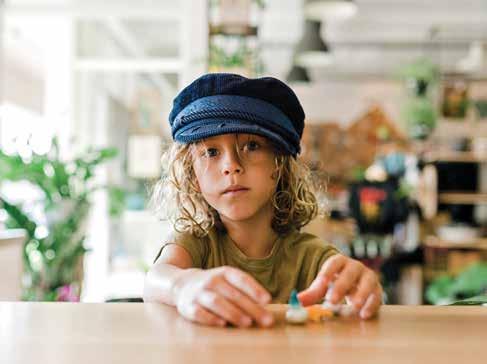

128 | FLUXHAWAII.COM

FLUXHAWAII.COM | 129
Dixie wears a linen shirt and pants, both from We Are Iconic. Rosie wears Australian brand Millk.co.
BIRCHER MUESLI
oo in the oses’ fridge, and you may find ircher muesli, a brea fast staple in ustralia that is a version of overnight oats. i ie learned to ma e it at a favorite caf , and eeps it on hand for a simple morning meal or ready to go snac . Try it at rvo when it is on special, or follow i ie’s simple recipe to ma e the muesli for yourself
servings
2 cups rolled oats
1 apple, chopped
1 cup walnuts or nuts of choice
1/4 cup honey
1 cup milk of choice
1 cup apple juice
1 cup Greek yogurt (or homemade coconut yogurt)
1/2 cup raisins
1/2 cup dried apricots, chopped
Mi all ingredients, seal in container, leave it in fridge overnight. efore serving, top with additional fresh fruit or fruit puree.
Dixie wears an Aloha Superette dress. Bowls and plates from Mud Australia, available from Echo and Atlas in Chinatown. The palm tree wallpaper is a collaboration between Mason and Kawaiian Lion. Plants and pots from Paiko. Couch from Inspiration.

130 | FLUXHAWAII.COM


Making Room
Interior designer Michelle Jaime of The Vanguard Theory paints a picture of living well i a ai i, a d shares so e ell lear ed tips
TEXT BY ANNA HARMON
IMAGES BY JOHN HOOK

y the age of , Michelle Jaime li ed to regularly rearrange her bedroom, drawing up furniture plans and, as a self proclaimed Virgo, neurotically trying to find the perfect, tidy place for everything. One of eight children, si of whom are half siblings, Jaime grew up in awai i ai among a sprawling yet close nit family drawn to creative endeavors— her dad fi ed up old V buses, her grandfather was a hobby calligrapher, her brother avid now builds out interiors and boutiques li e cho and tlas and Sig on Smith. Jaime followed her own creative drive after earning an undergraduate degree in psychology, leaving O ahu for alifornia ollege of rts in San Francisco to study architecture. She returned to awai i to pursue a doctorate in interior architecture at the
Bookshelf accessories from Hound and Quail, Aloha Superette, and Greenroom Hawai‘i create a midcentury vibe at The Surfjack Hotel.
132 | FLUXHAWAII.COM
LIVING WELL | S G

THECURRENTOFHAWAII.COM | 133
Jaime wears a Yireh dress and Jason Dow jewelry.
niversity of awai i, but dropped out when she got a ob at hilpotts nteriors, having reali ed that interior design was her calling.
Three years later, the economy tan ed, and she found herself obless. Jaime wor ed independently, but ept in touch with former cowor er Judy ndrade. couple years later, they struc out together, founding The Vanguard Theory. There was this void for a younger voice in the design field, Jaime says. ow see that everyone who was spurred on by that recession made something really cool. The company has quic ly climbed the ran s of interior design firms in awai i, and in , it won a Gold ey and two Indie awards for its wor within The Surf ac otel in ai , where its restoration of the ground
floor took inspiration from the midcentury timeframe during which the hotel was constructed. For a new pro ect, a lu ury hostel housed in a structure built in , Jaime and Andrade are looking to the corresponding era for inspiration. ’m ma ing the whole office listen to ’ s music, Jaime says. e loo at old photography, maga ines, all that ind of stuff. e’re also loo ing at what uniforms would loo li e we’re not doing bell bottoms or anything li e that, but more the awaiian vibe, li e the baseball shirt that everyone had with felt letters.
Such concepts are more than charming visuals for The Vanguard Theory they connect to deeper stories. For the hostel concept, they want to reflect the significance of the corresponding era in awai i a decade when
Jaime starts the day early, waking up at 5 a.m. to workout at Pure Barre. Then, she heads to the office before anyone else arrives to power through emails and create a to-do list for the day, breaking down each task into the time it takes to complete. “I don’t do that every day, but I try to,” she says. “If I follow that, then I can get a lot more done.” Jaime wears a vintage top from BikiniBird in Kailua, and Jason Dow jewelry.

134 | FLUXHAWAII.COM


FLUXHAWAII.COM | 135

the Sunshine Festival set up in iamond ead, the niversity of awai i introduced the enter for awaiian Studies, and the voyaging canoe le a set sail for the first time. The ’ s were a really vibrant time for awai i, and we want to celebrate that and tal story about that, Jaime says. veryone understands midcentury, and beyond awai i, everyone loves midcentury. ut not a lot of people now how significant the ’ s were to awai i.
The Vanguard Theory has designed a range of pro ects, from private homes to sprawling resorts. ut living well in awai i doesn’t require much, according to Jaime. t its best, it loo s li e everyone sitting in their garage. aving that outdoor community space where everyone can congregate, whether it be a proper outdoor l nai or a carport, that is awai i, she says.
MICHELLE JAIME’S DESIGN TIPS FOR CREATING A COMFORTABLE SPACE:
GOOD LIGHTING MAKES A SPACE MORE INVITING.
For a home, go with a warm bulb color li e . The higher the number, the cooler the light color becomes. lso, dimmers are your friends.
INVEST IN GOOD BEDDING.
oo for natural fibers li e cotton or linen. Synthetics are not breathable and trap heat companies will mar et these fibers as wrin le free.
BE SAVVY ABOUT YOUR PAINT FINISH.
For home walls, use a flat finish, which will show a truer color. The higher the sheen, the more it will reflect light and show the te ture on the wall. igher sheens are great for areas that get more usage, li e an office, bathroom, or itchen. se an eggshell finish in these areas.
136 | FLUXHAWAII.COM
These framed photographs at The Surfjack Hotel were taken by Mark Kushimi.

locally sourced hardwoods 912 PUUHALE RD. WOODHI.CO @DSON_WOODHI FOR INQUIRIES 808.728.6143 DAE@WOODHI.CO shipping available worldwide
Custom furniture handcrafted from

HANG ART OR ASSEMBLE ACCESSORIES IN ODD NUMBERS. don’t have a specific reason why, but it always loo s better.
DECORATE YOUR HOME TO REFLECT YOUR STYLE.
Some people cut out a picture in a maga ine or copy and paste designs from interest. Though these are great points of inspiration, ma e sure to in ect your own personality into any space.
FOCUS ON SIGHT LINES.
Thin about what you see from the entry, or from the beginning of a hall. These sight lines are a great opportunity to showcase artwor and to create a nice surprise around every corner.
HAVE ART IN YOUR WORKSPACE. ho li es to stare at paper and the computer screen all day ven if you have an ama ing corner o ce view, it’s nice to add a little culture into your space. e have lots of art in our o ce, and it ma es me happy.
Michelle Jaime chooses interior paint finishes based, in part, on how much traffic the room will get.
For more information, visit thevanguardtheory.com.
138 | FLUXHAWAII.COM



Living Water
Punahou’s Thurston Memorial Chapel oats o a resh ater spri , blending the built and the natural.
TEXT BY TIMOTHY A. SCHULER
IMAGES BY JOHN HOOK
rchitecture is a visual art, and the buildings spea for themselves, the pioneering architect Julia Morgan once said. hich is true, but buildings can be lost in translation, too, becoming as unintelligible as an ancient dialect. Thurston Memorial hapel, which sits at the center of the unahou School campus in onolulu, spea s as fluently and as radically as it did years ago.
On a recent Monday morning, found myself in the dar ened chapel, its constellations of stained glass glowing in the early morning sun. had seen the building before, but this time, noticed details had missed. The chapel itself small, square, copper roofed, visible from across a large, grassy e panse is stri ing in its simplicity white plaster walls adorned with a few bands of stained glass and
a small copper cross. t the chapel’s base, a lily pond wraps around the corner of the building li e a truncated moat, its dar green color echoing the roof’s patina. assing under a wooden trellis covered in bougainvillea, emerge in a quiet courtyard ringed by ferns and shaded by a giant mon eypod tree.
Suddenly, the chapel is different. This side of the roof is clad in brown ceramic tile. eavy oa wood doors leading inside are inlaid with copper repouss é panels that depict the life of Jesus hrist. The materials are warmer and more inviting. The rest of the campus feels far away.
This arrival sequence is part of the architectural design, carefully choreographed to create a sense of intimacy and quiet. nside the chapel is the same hushed reverence, despite the myriad fourth and fifth graders that fill the pews, which are
When Ossipoff presented his design for the chapel in 1964, it was at once thoughtful and lunatic: The building would sit not just near the lily pond—it would sit in it.

140 | FLUXHAWAII.COM
LIVING WELL | G O


THECURRENTOFHAWAII.COM | 141

arranged in a semicircle around a coral altar.
Founded by missionaries in , unahou still requires students to attend chapel. bove the altar hangs a thin, wooden cross, illuminated by a sculptural s ylight. emar ably, there is water inside, too. nd fish. The lily pond flows into the chapel beneath a shortened section of the e terior wall.
The service commences li e any other Somber organ music, the lighting of candles. ut then, the ids burst into awai i loha. ed by a ubilant chaplain with an acoustic guitar, they sing hau oli e n pio o awai i nei Oli Oli There is
a prayer peppered with Hawaiian and several awaiian chants, including one that is dedicated to ele, the fire goddess. t feels somewhat surreal, listening to students sing to a awaiian deity in a hristian chapel beneath a cross. fter all, not so long ago, missionaries in the islands banned hula and the awaiian language. fter the service, the chaplains tell me they want all students, regardless of their religious bac grounds, to feel welcome in Thurston hapel. s it happens, this was also the intent of its architect Vladimir Ossipoff. t its dedication in , he said that he
hoped students in need of physical and spiritual shelter will naturally gravitate here, and that having come here, they will find the comforting solace they see .
The ussian architect had designed other buildings on the unahou campus, and he new that the fan shaped lily pond near the campus’ center was a place of deep signi cance. ined with small stones, the pond is fed by a freshwater spring, which has several legends associated with it. n the most well nown, an elderly couple who live beneath an old hala tree nd the area plagued by severe famine and drought. n separate dreams, the man
The lily pond flows into Thurston Memorial Chapel beneath a shortened extension of the exterior wall.
142 | FLUXHAWAII.COM

FLUXHAWAII.COM | 143



and the woman are told to uproot the tree. They do so, and freshwater gushes forth. They call it apunahou, or the new spring.
hen Ossipoff presented his design for the chapel in , it was at once thoughtful and lunatic The building would sit not ust near the lily pond it would sit in it. That had to be one of the gutsiest architectural moves, architect and unahou graduate ate Smith tells me. To the school’s trustees, Ossipoff proposed the structure be nestled into the northeast portion of the pond, li e a sheer faced peninsula, the water lapping at its plaster walls li e the ocean against chal y white sea cliffs. nside, the floor would slope down to the altar, bringing students and teachers as close to the spring as possible. The water would even flow directly into the building.
Ossipoff assured the school it could be done. retaining wall was built across a corner of the pond and the water pumped out. The foundation was
The chapel building is completely inextricable from its site and the legend that resides there, writes architect Dean Sakamoto.

146 | FLUXHAWAII.COM

FLUXHAWAII.COM | 147

carefully sited, so as not to damage the spring. y , the chapel was finished, constructed almost e actly the way Ossipoff had designed it. Fifty years later, Thurston hapel is still regarded as one of the architect’s best wor s. ut what is perhaps most interesting is that the building, in a way, saved the lily pond.
espite irrevocably altering its shape, Thurston hapel actually reinforced the import of the spring, the water of which, by the th century, was being diverted for fountains, irrigation systems, and the school’s rst swimming pool. mong the earliest traditions associated with the pond was a dun ing ceremony, a sort of freshman ha ing ritual involving costumes and a parade. nd in a master plan for unahou, drawings show the lily pond ringed by an
imposing stone colonnade, which would have relegated the pond to being a passive feature of the landscape.
nstead, Ossipoff forged a new, more active relationship between the school and the spring, marrying the built and the natural. The chapel building is completely ine tricable from its site and the legend that resides there, ean Sa amoto, a awai i born architect, wrote in Hawaiian Modern: The Architecture of Vladimir Ossipoff . t is at once awaiian, modern, and timeless. Timeless, but also boundless, rooted in something bigger than any one religion. That visitors descend into the chapel, and that the altar sits at the lowest point in the building, ma e it an anomaly among places of worship. To enter any other church or temple, a person almost always
ascends a set of steps. This is practical, in part, but it is also symbolic, distinguishing between the mundane and the sacred, and, in certain faiths, bringing congregants physically closer to God. t apunahou, Ossipoff brings occupants closer to the ground. God, he seems to suggest, resides not ust in the heavens, but also on the earth.

148 | FLUXHAWAII.COM









FLUXHAWAII.COM | 149 HNL NON - STOP LAX Six Days/Week Next Day Service VIP Pet Service Oversize Items From Aston Martins and Outsize Cartons, to Polo Ponies and Man’s Best Friend. PACIFICAIRCARGO.COM 808 - 834 - 7977 cameronbrooksart.com ALWAYS STRESS FREE WHEN YOU P.A.C. IT


SPECIAL SECTION: THE FLUX SHOP
 Presented by Hawai‘i Tourism Oceania
Presented by Hawai‘i Tourism Oceania
PRESENTED BY
HAWAI‘I TOURISM OCEANIA

HAWAII SHOP
Presenting Hawai‘i to the world
The FLUX Hawaii Shop, presented by Hawai‘i Tourism Oceania, features curated wares from Hawai‘i-based artisans, crafters, and designers, showcasing the islands’ modern and diverse culture. This weeklong pop-up shop takes place in Sydney, Australia, a dazzling urban jewel on the southeast coast of Australia. In addition, FLUX will debut a new line of products made in collaboration with select vendors that will be sold exclusively at the shop during its launch. For more information, visit events.fluxhawaii.com.
The FLUX Hawaii Shop is in partnership with:

Tailored to Fit
Two co pa ies re e e s style in Hawai‘i.
TEXT BY LISA YAMADA-SON
IMAGES BY AJ FEDUCIA

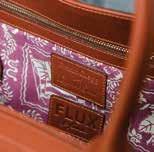
The biggest misconception about men’s style in awai i, according Tom ar , proprietor of menswear shop eather Soul, is that we all wear ill tting, open buttoned, sil y, Magnum, P.I. aloha shirts. ith lines li e eyn Spooner creating tailored, modern ts, that notion couldn’t be further from the truth. ’ve always loved eyn Spooner, from bac when was a nancial advisor out of college, ar says. They were the rst in the early s to do a preppy, toned down, business aloha shirt, using their J. ress and roo s rothers connection to ma e a reverse print, button down collar shirt with their Spooner loth,
Get this limited edition Frank Clegg working tote, made in partnership with Leather Soul, FLUX Hawaii, and Reyn Spooner.
154 | FLUXHAWAII.COM
THE FLUX SHOP M S




THECURRENTOFHAWAII.COM | 155
A Reyn Spooner shirt and shoes from Leather Soul make up the uniform of businessmen in the islands.
which is very similar to an o ford cotton.
Si years ago, ar approached the president of eyn Spooner, ir ubbard , to create an updated fit on the classic aloha shirt. The resulting garment, which quilted together warm hues of classic Spooner loth, was a hit with ar ’s discerning clientele, and a perfect complement to eather Soul’s premium leather shoes, which include offerings from John obb, lden, and Saint rispin’s.
eople in awai i are very laidbac , and it shows in the fashion you hardly see anyone in a suit here, ar says. nstead, everyone from high profile Os to start up graphic designers dons the shirt of the isles daily. Still, ar notes the importance of the small details when it comes to men loo ing sharp in this uniform of the isles. ere, he provides three tips.
GET SHIRTS TAILORED:
ou can loo pounds lighter or heavier ust because of the fit of your clothes. ot enough guys get their clothes altered. ou’ve got to reali e that you are not built li e a mannequin. ny tailor can ta e in the sides of a shirt or shorten the sleeves, and you’ll be surprised how much of a difference it ma es when they do.
KEEP IT CLEAN: get a haircut every two to three wee s. fresh cut will ma e you loo and feel sharp.

FIND SOMETHING THAT GIVES YOU CONFIDENCE AND ROCK IT:
hether it’s a nice pair of shoes, a watch you’ve always wanted, or a pair of glasses you’ve always admired, find an accessory or article of clothing
that ma es you feel great when you wear it. That small boost of confidence will give you that e tra little something to help you ma e the deal, land the client, or climb the corporate ladder.
Whether it’s a nice pair of shoes or glasses you’ve always admired, find an accessory or article of clothing that makes you feel great when you wear it, recommends Leather Soul owner Tom Park.
156 | FLUXHAWAII.COM
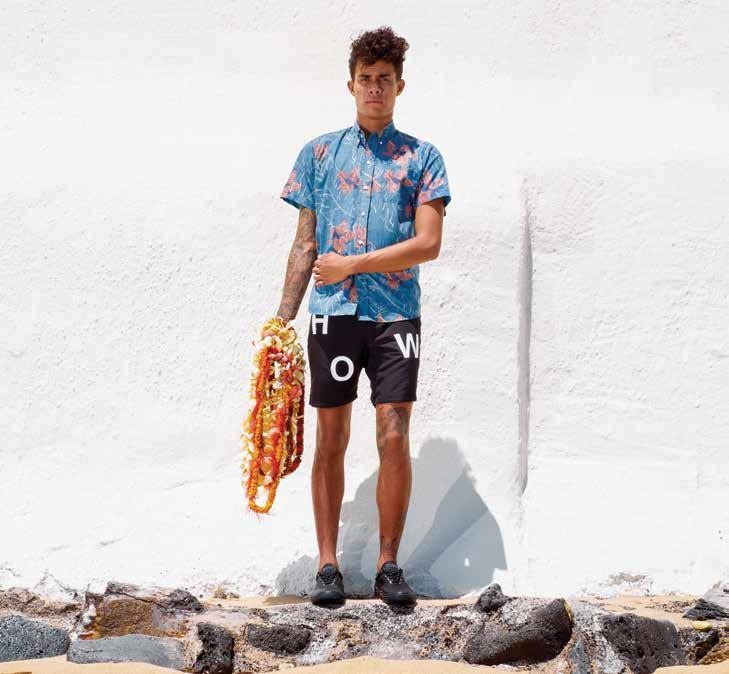
Salvage Public
AUAHI STREET
salvagepublic.com
SOUTH SHORE MARKET HONOLULU, HAWAI‘I
Salvaging Stories
The founders of Salvage Public tell a difere t story o s r a d a ai i ith their lifestyle brand.
TEXT BY LISA YAMADA-SON
IMAGES BY AJ FEDUCIA, JOHN HOOK, & COURTESY OF SALVAGE PUBLIC
t the base of iamond ead, that picturesque icon of awai i, there once e isted a surfing heiau, a shrine where huna, awaiian priests of the day, would fly ites to let people know of waves on the hori on. t was the surf report of the time. ac then, surfers could be heard calling out, a e ou aloha he enalu i a
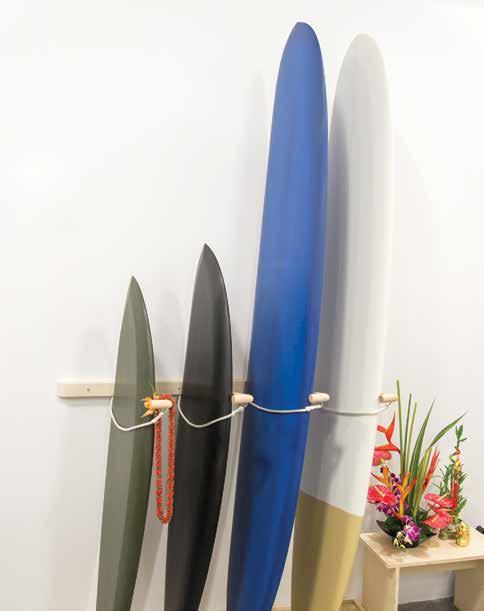
ho ua o n nalu show your love of surfing on the crest of the waves.
t was a way for awaiian people to say, ou can’t only tal the tal , you gotta wal the wal ,’ says pali Sou a, co founder of Salvage ublic. sing this phrasing to e press that idea shows ust how ingrained sur ng was to the way things were. t wasn’t ust a segment of the lifestyle, it was ust life.
rawing upon these stories as inspiration, Sou a and co founder Joseph Serrao along with their third partner, Joseph’s brother, oah began rolling out their contemporary, surf inspired wear for men. Starting with graphic tees, their line has grown to include a full collection that dresses men from head to toe, including ac ets, pants, and button down shirts.
Growing up in awai i, and being in and around the water from a young age practically living in oceanwear was what spar ed the designers’ foray into fashion.

For more information, visit salvagepublic.com or @salvagepublic.
158 | FLUXHAWAII.COM
THE FLUX SHOP M S

Salvage Public, which was founded by brothers Joseph and Noah
and N ā
features designs inspired by their personal experiences as Hawaiian surfers.
THECURRENTOFHAWAII.COM | 159
Serrao
pali Souza,
grew up as a id in the early ’ s, and what you clothed yourself in in my case surfwear was your identity, says Sou a, who counts Volcom among one of his childhood favorite brands. ac then, Volcom was doing something that was so different, that felt so rebellious and fresh. There was this whole culture that was wrapped up in a brand that you can wear and have become an e tension of who you are as a person.
The surf industry has long been driven by global companies, many of whom are headquartered in Southern alifornia, including the li es of ui silver, ip url, and urley. ut in the last decade, surf culture has entered the high end mar et, starting with the lifestyle brand Saturdays Surf , which debuted in and has gained global popularity. n , now called ering , the French lu ury group that owns brands li e Gucci and Saint aurent, acquired Volcom. n , a dreamy hanel o. campaign produced by a uhrmann featured supermodel Gisele ndchen surfing glassy waves atop a glossy blac hanel surfboard.
The idea for this brand started with a recognition of seeing a surf revival happening amongst different brands, and them not happening here out of awai i, or rather, not on a large enough scale where you’re seeing an impact, Serrao says. n response, Serrao and Sou a see to impart their personal e periences which

include learning to surf with family and friends, but also more comple issues that arise in everyday life into their brand. thin awai i is difficult, messy, complicated, ancient, and thin if you spend more than a vacation here, you begin to reali e that very quic ly, Sou a says.
s a result, Salvage ublic’s collection includes blac and white, color bloc ed boardshorts that hit above the nee perfect for staying mobile in the water alongside graphic tees with une pected type placements that turn local slang into high design concepts, and sweaters that turn character tropes meant to marginalize indigenous groups into emblems of power. sweater from the upcoming
fall winter collection, for e ample, is embla oned with a icasso esque ti i graphic and the words ooga ooga, a nod to the comedy ensemble, which included famed local comic ap eiplinger, that blasted through the narrative of native peoples as e otic but bumbling caricatures. sing that image in that way, Sou a says, is a degree of reappropriation, of turning the term on its head and presenting it in a way that’s representative of Salvage ublic, which is to say sophisticated and intelligent. Maybe that might spar somebody’s interest to learn more, Serrao says. Maybe they see out something we referenced that might give them a different viewpoint on awai i.
Joseph Serrao hopes Salvage Public’s designs will spark interest. “I think Hawai‘i is difficult, messy, complicated, ancient, and I think if you spend more than a vacation here, you begin to realize that very quickly.”
160 | FLUXHAWAII.COM

The Function of Fashion
Matt Bruening’s line of knits addresses the needs of modern women in Hawai‘i.
TEXT BY EUNICA ESCALANTE
PORTRAIT
IMAGES BY JOHN HOOK & COURTESY OF MATT BRUENING

esigner Matt ruening is a born and bred product of awai i. e was raised in M aha on O ahu’s west side, where miles and miles of warm white sand beach set the bac drop of his childhood. e answers the phone with a hearty ow it e goes to the ocean to meditate. is calf sports a tattoo of a palm tree. For ruening, who is part ative awaiian, the awaiian slands are not a stereotyped form of paradise they are home. onsequently, with his eponymous named clothing line, ruening’s designs pay homage to the world in which he grew up a world of contrasts, where

For more information, visit mattbruening.com or @mattbruening.
162 | FLUXHAWAII.COM
THE FLUX SHOP OM S
“What I present is what a modern-day Hawaiian would do, which is use craft to benefit society,” says Matt Bruening, who designs his womenswear line at his studio in Honolulu.

outside perspectives differed from his everyday e periences. s such, structured tops are fitted with an asymmetrical ruffle resembling the curve of a wave umpsuits, long and lean, imitate the fluidity of the ocean nits and surplus ac ets embla oned with the words Feel no waves, a play on the ra e song Feel o ays, reflect the calm, collected attitude ruening ta es when hit with life’s ups and downs.
s a child, ruening recalls wee ends spent at the beach, camping at M ua each with his family. My dad would pac the buc ets, we would catch fish, throw net, pic uni, he says. That was our isneyland. e couldn’t afford to go on any trips, but that was way better.
es grew up in a so called rough neighborhood,’ but to me, it’s one of the most beautiful places on earth, our little slice of paradise.
Growing up deprived of privileges other people had, as ruening says, only pushed him more. Television, the nternet of the early s, provided the budding creative with a window to the world. The glittering lights of the fashion industry bec oned, li e those that shone on endless runway shows playing on Style TV. big influence for me was the lines that emerged from hip hop culture, he says. hat saw them wearing, we couldn’t get here in awai i.
esigning for need as well as function is a concept that continues to inform ruening’s aesthetic
today. n addition to developing his own clothing line, ruening is also the creative director for Salt i o, a resort wear line speciali ing in unique prints and casual everyday wear. hat present is what a modern day awaiian would do, which is use craft to benefit society, ruening says. My craft involves dressing women so want to address the needs that people see everywhere else in the world, but tailored to people here in awai i.
THECURRENTOFHAWAII.COM | 163
Sliding Into First
From his O ah based sla d lipper factory, John Carpenter explains the importance of manufacturing in the isles.
TEXT BY LISA YAMADA-SON
IMAGES COURTESY OF ISLAND SLIPPER
Growing up, John arpenter was often reminded one thing by his father, a alifornia rancher who moved herds on horsebac and roped cattle by hand ou don’t wear a cowboy hat unless you’re a cowboy. Today, at arpenter’s , square foot sland Slipper factory in earl ity, this notion of authenticity rings true. There should be a deep

connection between who you are and where you’re from, says arpenter, owner of sland Slipper, the last remaining manufacturer to ma e all of its footwear in awai i. e reflect awai i and the lifestyle through our sandals and how we do business. e couldn’t ma e what we ma e anywhere else in the world.
Things weren’t always this way. n , the Motonaga family, who founded the company in , sold the business to arpenter, who had moved to awai i and found himself wor ing in the local footwear industry. arpenter had dreams of massively e panding the company, and began securing large accounts li e ostco, Macy’s, and est Marine. To ma e e pansion possible, arpenter began outsourcing a portion of the production to hina. Then arpenter got a call from a customer in Florida who had been purchasing sland Slipper’s products for decades. ust noticed this new one says, Made in hina,’ arpenter recalls the caller saying. always bought your shoes because you’re sland Slipper. am tal ing to sland Slipper, aren’t arpenter found himself having to e plain the company’s process that some parts of production
For more information, visit islandslipper.com or @islandslipper.
164 | FLUXHAWAII.COM
THE FLUX
FOOT
SHOP

Island Slipper’s origins date to 1946, when the Motonaga family began manufacturing slippers in Hawai‘i.

were done in awai i, while others weren’t. was confusing myself about what our direction was arpenter recalls. That was when we had a come to Jesus moment. e sat down, loo ed at the company, and said we’re going to pull everything bac to being made right here in the islands.
Since then, arpenter has remained committed to doing ust that, and every pair is handmade on O ahu. ach day, the sland Slipper factory floor hums with activity, as e perienced craftsmen cut, trim, wrap, sew, glue, and press each pair of the more than styles of men’s and women’s footwear.
This dedication, however, did not come without costs. eing made in awai i is one of our company’s main pillars, arpenter says. owever, it is also an chilles’ heel, a limitation on the business. e ac nowledges the financial struggle that came after he cut ties with the company’s big bo retail outlets. lot of times, we
have to say, ey, we won’t do that, because we ust can’t support it.’ ut smaller runs and in house production have enabled sland Slipper to quic ly amend styles based on customer feedbac , and to remain relevant in a retail landscape where tastes are constantly changing. So, too, has opening bric and mortar locations. n , arpenter debuted the company’s rst store at ard arehouse, despite many in the industry telling him a standalone slipper store would fail. hile it did end up closing, this e periment led to the introduction of sland Slipper retail stores at la Moana enter and oyal awaiian enter. The retail stores serve as a testing ground to forecast the success of new styles, and we are able to directly infuence the entire lifecycle of the product, from ma ing the slipper to tting and delivering it to our customers’ feet, says Tersha, John’s daughter in law. The retail stores create an endless loop.
Smaller runs have also forced arpenter to be more mindful about the brands with which sland Slipper partners. e loo s to the ne t generation for guidance. s they begin to ta e the reins of the family business, arpenter’s son, Matt, and his wife, Tersha, have pioneered unique distribution points in places li e ew ealand, ustralia, and ubai, and spearheaded partnerships with brands li e i , Salvage ublic, uc berry, and F maga ine, which debuted its e clusive sland Slipper slide in May. hat ’ve learned is that there’s a mar et around the world for this type of authenticity, arpenter says. very pair of sandals contains our ohana, our family, as well as all the materials and care that ma e it special.
THECURRENTOFHAWAII.COM | 165
Printed Matter
TEXT



t night, during that mystical stretch of time between sleep and consciousness, Jana am has visions. She dreams of palm leaves and plumerias, of pineapples and seashells. She wa es up in the dar , scrambling to commit the reveries to paper before they slip from memory. This process might be why her patterns geometric prints of flowers, shells, and leaves set in pastel— seem so dreamli e.
am is a te tile designer who was introduced to the tactile art while attending the cademy of rt niversity in San Francisco. t her awai i ai home, which doubles
For more information, visit janalam.com or @janalam.
166 | FLUXHAWAII.COM
Jana a s hi sical, ha d pri ted te tiles a d accessories re ect the isla ds
BY EUNICA ESCALANTE
IMAGES COURTESY OF JANA LAM
THE FLUX SHOP SSO S

Many of Jana Lam’s products are handmade merely a few steps from her living room.

as a studio, am crams corners with rolls of vibrant fabric ready to be transformed into handbags, pillow covers, and pareos for her eponymous brand. She is constantly s etching ideas for new prints. ith the help of a small crew of seamstresses and colorists, many of her products are handmade merely a few steps from her living room.
Much li e the designs appearing in her dreams, am’s business came to her by happenstance. n , she and her husband moved bac to awai i. They were unemployed, suffering the aftershoc s of the recession.
veryone was being laid off and the economy was down, am says. didn’t now what to do.
er husband encouraged her to build a printing table and start creating. y ovember of that year, she had a portfolio filled with designs, which she ended up showing to a boutique owner who commissioned her to ma e handbags for her store. Seven years and two toddlers later, am’s hobby has blossomed into a full fledged accessory company, with products carried by stores as large as ordstrom.
am’s designs continue to be an homage to her life in awai i. The motifs are inspired by the lush greenery and miles of beach that surround her home. The tessellating patterns are a tribute to the aloha print, which has been a part of awai i culture since the s. verything is very awai i inspired, am says. ut ’m not trying to be that person. t’s ust who am and the way that thin . n her bright designs, am envisions a dreamier awai i.
THECURRENTOFHAWAII.COM | 167
A Good Impression
Cari
Nakanishi’s
letterpress stationery is the perfect way to send island cheer.
TEXT BY KAYCEE MACARAEG
IMAGES BY GABE ESTEVEZ
t Miemi o telier, it’s easy to get lost in the array of print creations that ll the co y shop, including stationery that celebrates nearly every type of occasion. ’ve always li ed paper, says owner ari a anishi, who has long been more fascinated with the pac aging details of things she purchased than the products themselves. ut it wasn’t until a friend enlisted her to create a party invitation that
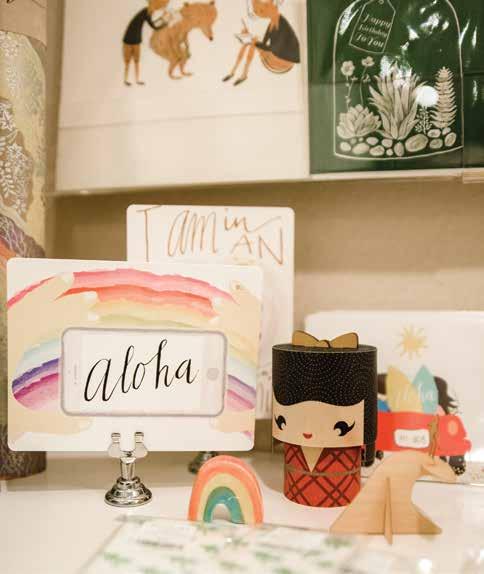
a anishi’s foray into stationery was reali ed. eady to deepen her s ills, a anishi enlisted in a wee long course in San Francisco to learn how to operate a letterpress. ot long after, she serendipitously received one of her own as a gift. hat drew a anishi to the letterpress was its tactile nature. The printing press provided a anishi, a self proclaimed lover of process, the opportunity to learn and ma e mista es. t wasn’t something that was immediate, she says. ou have to learn through it, too.
Today, a anishi’s paper goods, which range from invitations to business cards, are printed by hand and run through her massive pound press. Her creations bear delicate imprints of iamond ead or awaiian fora the perfect medium through which to send a bit of aloha. a anishi says ust want people to feel some ind of oy from my products and also use it to connect with others.

168 | FLUXHAWAII.COM
For more information, visit
THE FLUX SHOP ST T O
miemiko.com or @miemiko_co.

The pineapple shape of the cookie is a federally registered trademark of the Honolulu Cookie Company. May 2017. FLUX Hawaii Magazine. For the Very Best, Look for the Pineapple Shape ® honolulucookie.com | | @honolulucookie | 1-866-333-5800 OAHU Ala Moana Center | Waikiki Beach Walk® | Hilton Hawaiian Village | Royal Hawaiian Avenue | Waikiki Beach Marriott | Hyatt Regency Waikiki Royal Hawaiian Center | Outrigger Waikiki Beach Resort | International Market Place MAUI Front Street | Whalers Village | The Shops at Wailea LAS VEGAS Grand Canal Shoppes at The Venetian | The Palazzo | The LINQ Promenade GUAM Micronesia Mall
OluKai
OluKai crafts footwear for living the ocean lifestyle.



Olu ai is a lifestyle brand that believes everyone, no matter where they are, can live aloha. Olu ai’s nywhere loha campaign proves that though aloha was born in Hawai‘i, it is a spirit not bound by geography. Olu ai products feature thoughtful design elements and handcrafted details inspired by the ocean lifestyle. Select styles from the fall collection will be available at the F Shop in ustralia. hec out the Olu ai wor shop, where you can have an artist laser engrave by hand a custom piece of artwork or personalize a leather accessory.
For more information, visit olukai.com or @olukai.
170 | FLUXHAWAII.COM
FLUX
THE
SHOP FOOT

brings together creatives from around the world.
THECURRENTOFHAWAII.COM | 171
OluKai
Here, Bobbie Hanohano, from O‘ahu, and Hinatea Boosie, from Tahiti, visit Hanapepe’s Talk Story bookstore.
Keen on the Curl
Steven ea s s r i spired oodbloc prints convey the energy of the ocean.
TEXT BY EUNICA ESCALANTE
IMAGES BY JOHN HOOK



Five years ago, when Steven ean was cruising along O ahu’s orth Shore in search of an afternoon’s surf brea , he drove past a Vans Triple rown of Surfing venue. oung and perhaps a little naive, he daydreamed of being the competition’s official artist, with his artwor plastered on flyers, signs, maybe some T shirts. t the behest of a friend, ean submitted his wor for consideration. t was denied. e shrugged it off, setting the fantasy aside for another day. rt was a childhood friend of ean. is other constant companion, surfing, he met as a teenager, after his brother brought home a board. Enamored, Kean spent weekends weaving through waves along the
172 | FLUXHAWAII.COM
THE FLUX SHOP TS

For his woodcut prints, Steven Kean meticulously carves designs into a block of wood, coats it in ink, and carefully presses it onto paper.
THECURRENTOFHAWAII.COM | 173

ennsylvania coast. hen the year old came across the Triple rown, he was fresh off a three month stint in ustralia, where he had surfed his way up the Gold oast and too watercolor classes in his spare time. t was the ind of trip you ta e after uprooting your life, which ean indeed had done, leaving behind his e istence as a high school art teacher in ew Jersey in e change for the bluer s ies, warmer weather, and better waves of awai i. ere, during an independent study at the niversity of awai i at M noa, ean was introduced to woodbloc printing, a printma ing method that involves meticulously carving designs out of a piece of wood. The ocean became ean’s muse, his portfolio filled with variations of waves curling and billowing s yward, designs that too hundreds of carves to perfect.
t usually ta es ean a wee to cut such a design from a bloc of wood. e t, he coats it in a layer of in and carefully presses it onto fabric or paper. The result is reminiscent of art from Japan’s do period strong lines vividly depicting the swelling curves of a wave.
These days, ean is riding a wave of success, holding solo e hibitions and even achieving his seemingly unattainable dream e has been named the official artist of the Vans orld up, the second event of the Triple rown. hether featured on posters at Sunset each, or hanging on a living room wall, ean’s woodbloc prints convey energy and a sense of being alive, with each carve, and every wave.
Kean’s prints are reminiscent of art from Japan’s Edo period: strong lines vividly depict the swelling curves of a wave.
Follow Kean on Instagram @keanarts.
174 | FLUXHAWAII.COM
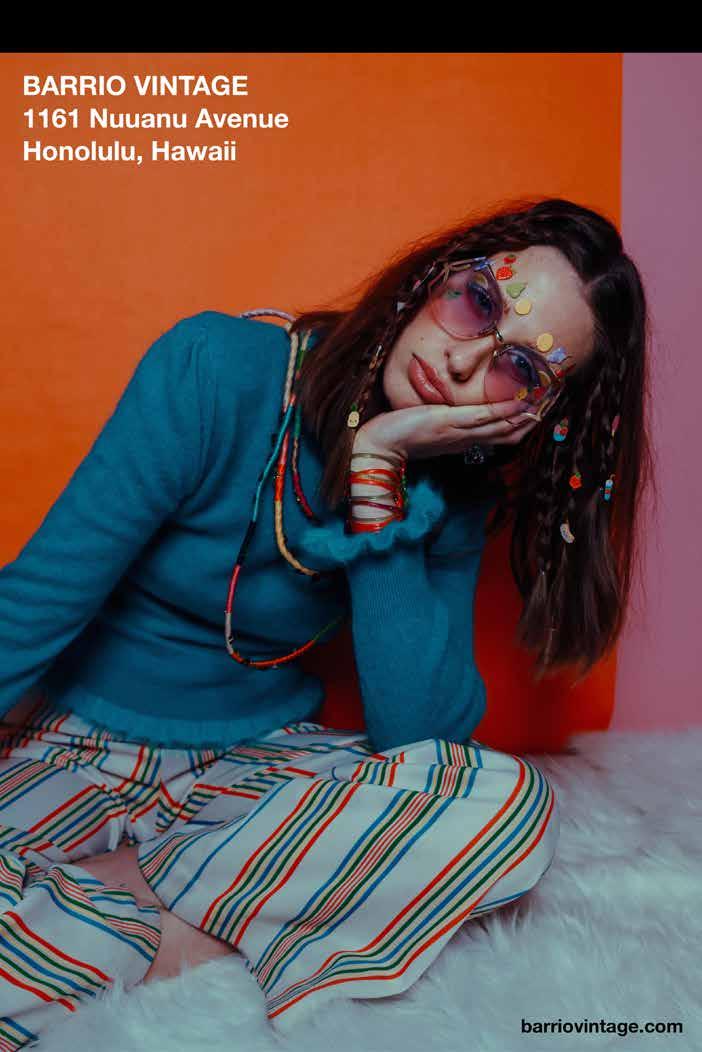
FLUXHAWAII.COM | 175

HVN
Apparel
Growing up in awai i, graphic designer Travis to saw the ocean as a sanctuary, a place of rela ation, and a one for living in the moment. ut as his favorite beaches became littered with trash, to new he had to do something to help preserve the world that had always inspired him, and so he launched V an abbreviation of the word haven , a line of eco conscious apparel made
using more sustainable fabrics li e hemp, bamboo, and organic cotton. V was inspired by my e periences growing up in one of the most culturally, environmentally, and economically diverse places in the world, to says. V ’s pieces are meant to be conversation starters, and a portion of apparel sales goes to funding beach cleanups. The solution is simple ncrease the awareness
that there is a problem, and inspire people to take action, to says. y using apparel as a canvas to share this message, our aim is to pioneer a movement that ma es a sustainable lifestyle and sustainable topics a part of the everyday conversation.
For more information, visit hvnapparel.com.
176 | FLUXHAWAII.COM
THE FLUX SHOP



Beachcake
Mari o Merritt grew up making art and inventing imaginary worlds inspired by the beaches and forests of awai i. For her handcrafted brand, eachca e, she creates whimsical, nature inspired ceramic objects and vessels and screen printed greeting cards in her M noa Valley studio. hildren’s boo illustration and graphic design pro ects complement her wor as an artist and maker, and together, all of these creative endeavors help her to pursue the wholly creative life she dreams of.
For more information, visit marikomerritt.com or @heybeachcake.


Jams World
MADE IN HAWAI‘I SINCE 1964
n , surf shop owner ave ochlen couldn’t find the right shorts to surf in. is wife hemmed bright, baggy pa ama pants at the nee, and the s beach scene was never the same. Fifty years later, Jams orld is now a premium resort line nown for its lu ury fabrics and fantastic prints. ach print ta es you on a ourney to feel something new. ll pieces are designed, cut, and sewn in onolulu, where Jams orld owners continue to live, wor , and play.
For more information, visit jamsworldshop.com or @jams_world.
178 | FLUXHAWAII.COM
THE FLUX SHOP TS



Located in the historic Waialua Sugar Mill. Call us to schedule your Behind-the-Scenes Tour. Visit the North Shore Soap Factory Our handcrafted natural and organic skincare line is gentle on your skin, safe for our oceans. www.hawaiianbathbody.com artisan soap and natural skincare. 67-106 Kealohanui Street, Waialua | northshoresoapfactory.com home of for your
SSO S FOO
Martin and MacArthur
There’s no better place to find awai i’s best craftsmen than at Martin and Mac rthur, which is distinguished as being the fine furniture ma er of record for olani alace. ts artisan ma ers, in fact, rebuilt the grand oa staircase in the palace. Today, Martin and Mac rthur also features innovative oa items li e watches, rings, sunglasses, i hone cases, and ewelry. atrons of Martin and Mac rthur can also en oy bron e sculptures by the Frogman, Tim otterill, and ig sland surfer hris arela, as well as glass sculptures by aniel Moe and van Schauss. long with these artfully crafted items, find diamond and gold ewelry by Maui designer Mi el, limited edition handbags made by merican artisans, and the e quisite awaiian feather lei by master oris uang.
For more information, visit martinandmacarthur.com. THE FLUX SHOP


Honolulu Cookie Company
onolulu oo ie ompany loo s to spread the spirit of aloha around the world with premium shortbread coo ies made in awai i. ach coo ie is ba ed fresh daily, made with the finest ingredients and natural awaiian flavors, and individually wrapped to maintain its delicious oven fresh quality. ts coo ies are pac ed by hand in unique signature pac aging to ensure that each bo can be presented as a treasured gift, from its ohana to yours.
Find Honolulu Cookie Company stores throughout O‘ahu, Maui, Las Vegas, and Guam, as well as online at honolulucookie.com. Follow Honolulu Cookie Company on Instagram and Twitter @honolulucookie.
180 | FLUXHAWAII.COM
Hawaiian Bath and Body
andcrafted on O ahu’s orth Shore, awaiian ath and ody natural and organic soaps and skincare cleanse, nourish, and moisturi e, so that you can shine in your natural beauty.
For more information, visit hawaiianbathbody.com or @hawaiianbathandbody.


THE FLUX SHOP S
Botanical Brunch Recap
IMAGES BY JOHN HOOK
The otanical runch celebrated F awaii’s lant ssue on the grounds of ale ope’s enchanting lolo Valley estate. osted in partnership with The edding afe, the balmy day included floral foraging and arranging with O i a founder Tamara igney, culinary delights by chef James pta in who you can read more about on page , and the musical stylings of ic urosawa.
To see more of our events, visit events.fluxhawaii.com.
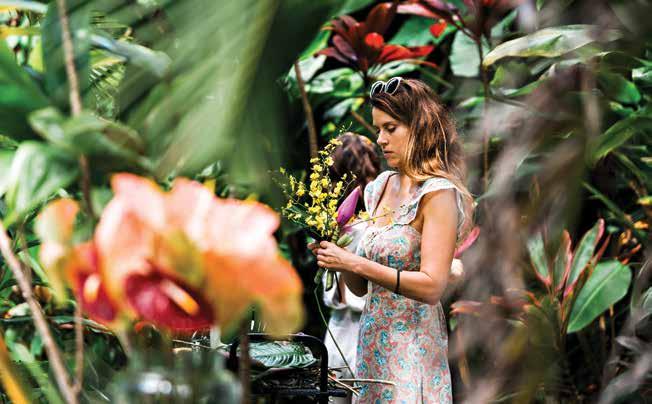


182 | FLUXHAWAII.COM
IN FLUX | S S V T

Want to join in on events like these? Subscribe now at fluxhawaii.com/subscribe.
FLUXHAWAII.COM | 183
IN FLUX | FOO
Savor the Flavor
Chef James Aptakin’s catering company,
Layers of Flavor, fuses his Floridian roots ith a ai i avors
TEXT BY EUNICA ESCALANTE
IMAGES BY JOHN HOOK



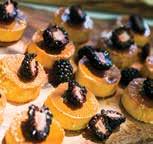
hef James pta in grew up with good food and good manners. oth are apparent as he fits around a cramped itchen an hour before appetizer service for a private event. Outside, guests who have arrived wearing their Sunday best sip mimosas and laugh in the morning light. The itchen, meanwhile, is a diferent scene, as the chef dashes around plating p p . ut pta in is calm amid the chaos completely in his element in the bustling environment. fter all, the Miami local has been coo ing since he was a child.
t years old, pta in was adopted by inda ayer, who pulled the s inny child into her itchen whenever she coo ed, as a way to get him to eat more. y fifth grade, pta in was ma ing stir fry and serving full meals to his family. new then had a love for it and wanted to be a chef, pta in says. n , he moved to San Francisco, oined the avy, and was tas ed with coo ing for , sailors aboard an aircraft carrier.
184 | FLUXHAWAII.COM

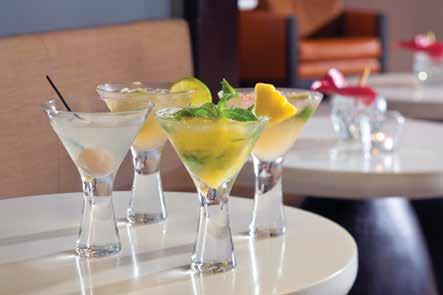




PUB: Issue: Client: AD: Size: (7.5” Colors: DUE: HOTELRENEW.COM | 844-HTL-RNEW (485-7639) WELCOME TO WAIKIKI’S SOPHISTICATED SIDE Experience an eco-friendly oasis of exceptional service located just steps to Waikiki Beach, shopping and dining. 72 modern guestrooms. Exclusive privileges include our convenient mobile concierge service.
ater, when he was an e ecutive chef for ilton in San Francisco, pta in met his future wife, uth, while presenting dishes to her table. n , after getting married, the pair moved to awai i, where uth was from. namored with the unique flavors of the islands’ local cuisine, pta in cultivated his style during stints as e ecutive chef at ilton ai i i each hotel, then as e ecutive chef at the ai mainstay Mac . Then, in , pta in started his own catering company, ayers of Flavor. Moving to awai i was not only a dream come true, as far as living in paradise, pta in says. t’s living in food paradise.
Today, pta in fuses awai i’s an sian, an aci c cuisine with favors from the Floridian and South merican food of his roots, producing unique combinations, such as Vietnamese rolls made with ualoa anch shrimp and salted caramel tru e shoyu, tea smo ed charred amachi, and furi a e crusted macaroni and cheese balls made with seven cheeses from local artisan a ed ow airy. pta in remains ardently committed to sourcing from local purveyors. Many of the chef’s dishes are infuenced by his early days in the itchen, drawing on childhood memories of soul food creations that he and his mother coo ed together. Today, pta in still ta es the same boyish delight in his coo ing. Finally able to step out of the itchen after hours of

hustling, he charms guests as he describes his main course. Food brings people together through good and bad times, pta in says. That’s what drew me into coo ing in the first place.
For more information, visit layersofflavor.com.
186 | FLUXHAWAII.COM



Island Hopping by Cocktail
ith distinct resorts, you’ll find more reasons to sip and savor an eclectic tour of coc tails in the most stunning settings across four awaiian slands.
KAUA‘I
The longstanding loody Mary has been a part of the St. egis history since , and at The St. egis rinceville esort, guests will find a unique version served with local flare. nspired by the classic film South Pacific , which was shot on the island of aua i, the loha Mary combines local flavors, including Sriracha, wasabi, and sea salt smo ed
with guava wood, which imparts a rich and comple oceanic flavor to the coc tail.
O‘AHU
The famed Mai Tai ar at The oyal awaiian, a u ury ollection esort has been perfecting the tropical drink since Trader Vic first created the oyal Mai Tai in . s one of the most classic drin s in awai i, the mai tai remains a favorite among visitors and locals ali e. Today, guests can also en oy a refreshing lineup of classic coc tails with a modern twist alongside spectacular views and live entertainment nightly.
MAUI
elish Oceanside is The estin Maui’s signature restaurant, ofering island inspired cuisine and the best seats on anapali each. Finish of a delicious meal with the utty Hawaiian, a decadent cocktail made with macadamia nut liqueur, vanilla
infused vod a, chocolate, and coconut syrup. awai i is the only state in the .S. to farm cacao. ts plentiful macadamia nuts and coconuts are also legendary, ma ing consuming this coc tail an en oyable way to celebrate Maui’s agricultural bounty.
HAWAI‘I ISLAND
The ona Manhattan brings a new level of sophistication to Sheraton ona’s oceanfront restaurant, ays on the ay. rawing from the flavors of the ig sland, the martini style coc tail includes flavorful ona coffee and awaiian guava grape wine from Volcano inery. The carefully crafted coc tail is best en oyed during the sunset hour or overloo ing the ma estic manta rays swimming offshore.
For more information, visit dininginhawaii.com.
IN FLUX | OMOT O
188 | FLUXHAWAII.COM


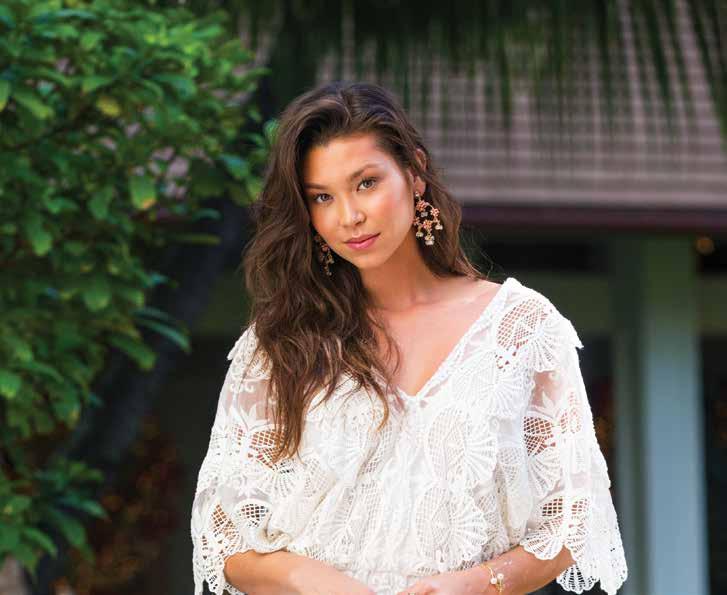





Mon-Sat 9:30am to 9pm Sun 10am to 7pm • AlaMoanaCenter com • 808.955.9517 • FREE WI-FI Your GGP Shopping Destination MORE THAN 340 STORES AND RESTAURANTS INCLUDING AERIE • ANTHROPOLOGIE • BLOOMINGDALE’S • BRIGHTON COLLECTIBLES • DANIEL WELLINGTON • EXPRESS KATE SPADE NEW YORK • MACY’S • MAI TAI BAR • NEIMAN MARCUS • NORDSTROM • RIX ISLAND WEAR SUNGLASS HUT • THE LEGO STORE • THE REFINERY HONOLULU • WILLIAMS-SONOMA • ZARA • & MANY MORE
The Plantation Inn
perience the getaway you deserve at Maui’s premier bed and brea fast, The lantation nn. ith plantation style architecture and d cor combined with modern amenities, the inn offers guests rela ation in the heart of Maui’s historic hain Town. The lantation nn’s two buildings house beautifully decorated rooms, a secluded tiled pool, and a Jacu i bordered by an array of lush awaiian ferns. ere, guests can bas undisturbed all year long beneath Maui’s warm sunshine.
For more information, visit kbhmaui.com/plantation-inn.

IN FLUX | OMOT O 190 | FLUXHAWAII.COM
A Tranquil Escape in Waik ī k ī
perience the best of both worlds at otel enew, located right in the heart of ai , ust a short wal to the beach. Offering an oasis of calm ust steps to the action of ai , this spa inspired designer hotel has the natural elements in mind, coupled with a sophisticated eye for style that curates a sense of peace in paradise. From the custom aroma concierge to the quiet enclave of the tranquil lobby that invites one to en oy quiet moments of rela ation, a stay at this boutique hotel focuses on providing a sense of serenity. ppointed with modern accommodations, e tra amenities, and dog friendly rooms,


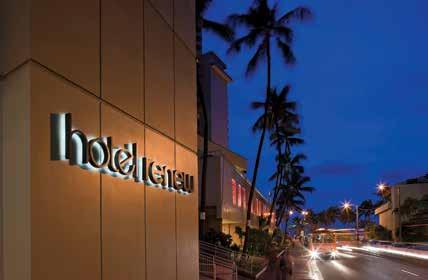
otel enew remains the hotel for travelers looking for an escape from the ordinary. Guests leave the day to day office worries behind the moment they arrive at the hotel. Just beyond the hotel’s entrance, ai each, fabulous shops, and e citing





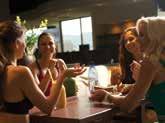

(808) 585-9626 932 Ward Ave. 7th Floor Honolulu, HI 96814 www.honoluluclub.com thehonoluluclub HonoluluClub Hawaii’s premier athletc, social and networking destnaton.
restaurants
once you’re
to reconnect
For more information or to book a reservation, visit hotelrenew.com. IN FLUX | OMOT O
await,
ready
socially.
Tombstone Tourism
In a alley, a local riter ds himself among the graves of Hawaiian royals and foreign interlopers.
TEXT BY TRAVIS HANCOCK
ILLUSTRATION BY MITCHELL
FONG
hen ai Mai oho crac ed open the door of his small, green house in u uanu, could tell immediately that he was sic . e had the flu, he said, and wasn’t up to give a tour of the surrounding property, Mauna la, otherwise nown as the oyal Mausoleum.
n his s, ai was a top island s ateboarder and the owner of the earl ity s ate shop Mishen, which also happened to be my first s ateboarding sponsor. e also has a bloodline that traces bac to the original protectors of ing amehameha ’s iwi, or bones. s vessels of a person’s mana, or one’s spiritual essence, iwi, especially those of high chiefs, are closely guarded. n , when his father passed away, ai inherited the position as Mauna la’s official ahu, the guardian of the site and its two main depositories of royal iwi, the amehameha and al aua crypts.
n lieu of a tour, from which had hoped to draw material for a story, ai handed me a boo that his dad, ill Mai oho, had helped author on hapman write about Mauna la. n insightful history, the boo covers the successful petition led by ueen ili uo alani and obert ilco to remove Mauna la from the public domain. Then ai went bac inside to rest meanwhile, below us, the bodies of five awaiian ings, seven queens, nearly two do en royal offspring, a half do en high chiefs, and a handful of haole statesmen continued to rest as well. fter my brief visit, as drove out through gold tipped iron gates onto u uanu venue, passed beneath the low, thic arm of a amani tree that has gone untrimmed for decades li e another guardian offering protection against oversi ed vans that would surely ma e the mausoleum roundabout part of island tours, if given the chance.
alf a bloc away was O ahu emetery. remembered reading that the early awaiian politician and historian John apa was buried there and decided to pay my respects. Venturing down one of the sprawling cemetery’s paved lanes, past a row of far from home s whalers, suddenly came across the plot of orrin Thurston, the man who led the overthrow of the awaiian monarchy. grotesquely twisted pine tree rose up behind his rough hewn headstone.
fter an hour of meandering through plots of the namesa es of onolulu streets illingham, Metcalf, owsett, Monsarrat, Judd, ilder, Farrington found John ’s humble headstone. Set within a square of shrubs, lay at a distance from many of onolulu’s influential aucasians, but close to a patch of commemorative mar ers for awaiian royals, many of whom are buried at Mauna la. had also been a udge, recalled. Standing before his engraved name, felt a dawning sense of ustice in not being able to tour Mauna la, in being drawn away from the headliners of awaiian history to the relatively un nown gravesite of , who devoted his life to serving and documenting the amehameha dynasty. had allotted ust a single afternoon for this tour through the tombs. ho am to write of their bones
n fact, may have been more li e the outsider Mar Twain, when reporting on the funeral of rincess Victoria am malu. atching the procession ascend to Mauna la, Twain was baffled by the mi of estern decorum and unrestrained, emotional wailing signs of a people straddling disparate funerary traditions. may well have been there, too, gravely observing it all.
al ing bac to the car, reali ed that when paying ai future visits at Mauna la, would do well to watch my roof rac s as pass beneath the growing, swooping arm of that amani tree.
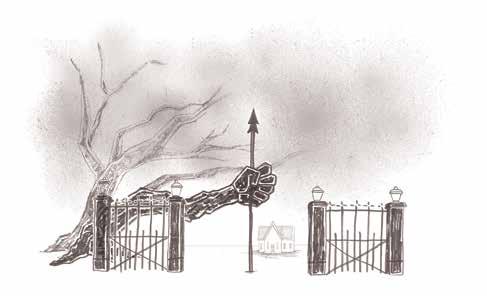
IN FLUX | O 192 | FLUXHAWAII.COM


Get this limited edition Frank Clegg working tote, made in partnership with Leather Soul, FLUX Hawaii, and Reyn Spooner. leather soul × reyn spooner × flux hawaii shop.fluxhawaii.com


































 Petroglyph at Pu‘u Moa‘ulanui on Kaho‘olawe. Image by Wayne Levin.
Petroglyph at Pu‘u Moa‘ulanui on Kaho‘olawe. Image by Wayne Levin.




















 IV. BIRTH OF SEA AND LAND LIFE
IV. BIRTH OF SEA AND LAND LIFE
 VIII. THE NIGHT DIGGER
VIII. THE NIGHT DIGGER
 XIII. THE FLOOD
XIII. THE FLOOD


 X. THE DOG CHILD
X. THE DOG CHILD

 XVII. THE DEDICATION
XVII. THE DEDICATION



 Retrieved shell casings found during cleanup sweeps of the island by the Navy Explosive Ordnance Demolition Crew.
Retrieved shell casings found during cleanup sweeps of the island by the Navy Explosive Ordnance Demolition Crew.



 Flume from an old cattle ranch.
Flume from an old cattle ranch.
 Major erosion above Hakioawa.
Major erosion above Hakioawa.









































 Image by Tara Rock.
Image by Tara Rock.












 Waikolu Valley on Moloka‘i. Image by Jeff Hawe.
Waikolu Valley on Moloka‘i. Image by Jeff Hawe.
















 KAUA‘I MAUI
O‘AHU
HAWAI‘I ISLAND
LEFT TO RIGHT: THE ST. REGIS PRINCEVILLE RESORT; MOANA SURFRIDER, A WESTIN RESORT & SPA; SHERATON MAUI RESORT & SPA; SHERATON KONA RESORT & SPA AT KEAUHOU BAY
SHERATON WAIKIKI, WAIK Ī K Ī BEACH, O‘AHU
©2017 Marriott International, Inc. All Rights Reserved. Starpoints, SPG, Preferred Guest, Sheraton, Westin, St. Regis, The Luxury Collection, W, Le Meridien, Design Hotels, Tribute Portfolio, Element, Aloft, Four Points and their respective logos are trademarks of Marriott International, Inc., or its affiliates.
KAUA‘I MAUI
O‘AHU
HAWAI‘I ISLAND
LEFT TO RIGHT: THE ST. REGIS PRINCEVILLE RESORT; MOANA SURFRIDER, A WESTIN RESORT & SPA; SHERATON MAUI RESORT & SPA; SHERATON KONA RESORT & SPA AT KEAUHOU BAY
SHERATON WAIKIKI, WAIK Ī K Ī BEACH, O‘AHU
©2017 Marriott International, Inc. All Rights Reserved. Starpoints, SPG, Preferred Guest, Sheraton, Westin, St. Regis, The Luxury Collection, W, Le Meridien, Design Hotels, Tribute Portfolio, Element, Aloft, Four Points and their respective logos are trademarks of Marriott International, Inc., or its affiliates.


























 Interior design details with Michelle Jaime. Image by John Hook.
Interior design details with Michelle Jaime. Image by John Hook.



































 Presented by Hawai‘i Tourism Oceania
Presented by Hawai‘i Tourism Oceania

























































































